Recent Developments in the Immersed Boundary Method for Complex Fluid–Structure Interactions: A Review
Abstract
1. Introduction
2. Overview of Numerical Framework
3. Application
3.1. Turbulence Modeling
3.1.1. Large Eddy Simulation (LES)
3.1.2. Direct Numerical Simulation (DNS)
3.1.3. Reynolds-Averaged Navier–Stokes Equations (RANS)
3.1.4. Hybrid Solvers
3.1.5. Influence of Fluid Solver on IBM Formulation
3.2. Complex Rigid Geometries
3.2.1. Diffuse Interface
3.2.2. Sharp Interface
3.2.3. Hybrid Boundary Treatments
3.2.4. Impact of Various Boundary Treatments
4. Limitations
5. Summary
6. Future Scope and Concluding Remarks
Funding
Data Availability Statement
Acknowledgments
Conflicts of Interest
References
- Peskin, C.S. Flow patterns around heart valves: A numerical method. J. Comput. Phys. 1972, 10, 252–271. [Google Scholar] [CrossRef]
- Iaccarino, G.; Verzicco, R. Immersed boundary technique for turbulent flow simulations. Appl. Mech. Rev. 2003, 56, 331–347. [Google Scholar] [CrossRef]
- Mittal, R.; Iaccarino, G. Immersed Boundary Methods. Annu. Rev. Fluid Mech. 2005, 37, 239–261. [Google Scholar] [CrossRef]
- Sotiropoulos, F.; Yang, X. Immersed boundary methods for simulating fluid–structure interaction. Prog. Aerosp. Sci. 2013, 65, 1–21. [Google Scholar] [CrossRef]
- Kim, W.; Choi, H. Immersed boundary methods for fluid-structure interaction: A review. Int. J. Heat Fluid Flow 2019, 75, 301–309. [Google Scholar] [CrossRef]
- Roy, S.; De, A.; Balaras, E. Immersed Boundary Method; Springer: Singapore, 2020. [Google Scholar] [CrossRef]
- Griffith, B.E.; Patankar, N.A. Immersed Methods for Fluid–Structure Interaction. Annu. Rev. Fluid Mech. 2019, 52, 421–448. [Google Scholar] [CrossRef] [PubMed]
- Mittal, R.; Bhardwaj, R. Immersed Boundary Methods for Thermofluids Problems. Annu. Rev. Heat Transf. 2022, 24, 33–70. [Google Scholar] [CrossRef]
- Verzicco, R. Immersed Boundary Methods: Historical perspective and Future Outlook. Annu. Rev. Fluid Mech. 2022, 55, 129–155. [Google Scholar] [CrossRef]
- Choi, J.I.; Oberoi, R.C.; Edwards, J.R.; Rosati, J. An immersed boundary method for complex incompressible flows. J. Comput. Phys. 2007, 224, 757–784. [Google Scholar] [CrossRef]
- De Tullio, M.D.; De Palma, P.; Iaccarino, G.; Pascazio, G.; Napolitano, M. An immersed boundary method for compressible flows using local grid refinement. J. Comput. Phys. 2007, 225, 2098–2117. [Google Scholar] [CrossRef]
- Ghosh, S.; Choi, J.I.; Edwards, J.R. Simulation of Shock/Boundary-Layer Interactions with Bleed Using Immersed-Boundary Methods. J. Propuls. Power 2010, 26, 203–214. [Google Scholar] [CrossRef]
- Capizzano, F. Turbulent wall model for immersed boundary methods. AIAA J. 2011, 49, 2367–2381. [Google Scholar] [CrossRef]
- Bai, X.; Avital, E.; Munjiza, A.; Williams, J. Numerical simulation of a marine current turbine in free surface flow. Renew. Energy 2014, 63, 715–723. [Google Scholar] [CrossRef]
- Specklin, M.; Delauré, Y. A sharp immersed boundary method based on penalization and its application to moving boundaries and turbulent rotating flows. Eur. J. Mech. B Fluids 2018, 70, 130–147. [Google Scholar] [CrossRef]
- Tamaki, Y.; Imamura, T. Turbulent flow simulations of the common research model using immersed boundary method. AIAA J. 2018, 56, 2271–2282. [Google Scholar] [CrossRef]
- Xu, L.; Tian, F.; Young, J.; Lai, J. A novel geometry-adaptive Cartesian grid based immersed boundary–lattice Boltzmann method for fluid–structure interactions at moderate and high Reynolds numbers. J. Comput. Phys. 2018, 375, 22–56. [Google Scholar] [CrossRef]
- Specklin, M.; Dubois, P.; Albadawi, A.; Delauré, Y. A full immersed boundary solution coupled to a Lattice–Boltzmann solver for multiple fluid–structure interactions in turbulent rotating flows. J. Fluids Struct. 2019, 90, 205–229. [Google Scholar] [CrossRef]
- Yoon, M.; Hwang, J.; Yang, J.; Sung, H. Wall-attached structures of streamwise velocity fluctuations in an adverse-pressure-gradient turbulent boundary layer. J. Fluid Mech. 2020, 885, A12. [Google Scholar] [CrossRef]
- Wiersema, D.J.; Lundquist, K.A.; Chow, F.K. Mesoscale to Microscale Simulations over Complex Terrain with the Immersed Boundary Method in the Weather Research and Forecasting Model. Mon. Weather Rev. 2020, 148, 577–595. [Google Scholar] [CrossRef]
- Arthur, R.S.; Lundquist, K.A.; Wiersema, D.J.; Bao, J.; Chow, F.K. Evaluating implementations of the immersed boundary method in the weather research and forecasting model. Mon. Weather Rev. 2020, 148, 2087–2109. [Google Scholar] [CrossRef]
- Wang, L.H.; Zhang, W.Y.; Hao, X.; Huang, W.; Shen, L.; Xu, C.; Zhang, Z. Surface wave effects on energy transfer in overlying turbulent flow. J. Fluid Mech. 2020, 893, A21. [Google Scholar] [CrossRef]
- Zhou, T.; Zhao, L.; Huang, W.; Xu, C. Non-monotonic effect of mass loading on turbulence modulations in particle-laden channel flow. Phys. Fluids 2020, 32, 043304. [Google Scholar] [CrossRef]
- Agarwal, A.; Gupta, S.; Prakash, A.S. A comparative study of bounce-back and immersed boundary method in LBM for turbulent flow simulation. Mater. Today Proc. 2020, 28, 2387–2392. [Google Scholar] [CrossRef]
- Ma, G.; Xu, C.; Sung, H.J.; Huang, W. Scaling of rough-wall turbulence by the roughness height and steepness. J. Fluid Mech. 2020, 900, R7. [Google Scholar] [CrossRef]
- Hwang, J.; Lee, J.H.; Sung, H.J. Statistical behaviour of self-similar structures in canonical wall turbulence. J. Fluid Mech. 2020, 905, A6. [Google Scholar] [CrossRef]
- Yang, J.; Yoon, M.; Sung, H.J. The turbulent/non-turbulent interface in an adverse pressure gradient turbulent boundary layer. Int. J. Heat Fluid Flow 2020, 86, 108704. [Google Scholar] [CrossRef]
- Wang, J.; Gu, X.; Wu, J. A sharp-interface immersed boundary method for simulating high-speed compressible inviscid flows. Adv. Aerodyn. 2020, 2, 23. [Google Scholar] [CrossRef]
- Zhang, J.; Zuo, Q.; Mu, L.; Huang, W.; Pan, W.; Cui, G. Evolution of vortices in the wake of an ARJ21 airplane: Application of the lift-drag model. Theor. Appl. Mech. Lett. 2020, 10, 419–428. [Google Scholar] [CrossRef]
- Tsvetkova, V.; Kozubskaya, T.; Kudryavtseva, L.; Zhdanova, N. On mesh adaptation for supercomputer simulation of flows around solid bodies defined by immersed boundary method. Procedia Comput. Sci. 2020, 178, 404–413. [Google Scholar] [CrossRef]
- Onishi, K.; Tsubokura, M. Topology-free immersed boundary method for incompressible turbulence flows: An aerodynamic simulation for “dirty” CAD geometry. Comput. Methods Appl. Mech. Eng. 2021, 378, 113734. [Google Scholar] [CrossRef]
- Tamaki, Y.; Imamura, T. Efficient dimension-by-dimension higher order finite-volume methods for a Cartesian grid with cell-based refinement. Comput. Fluids 2017, 144, 74–85. [Google Scholar] [CrossRef]
- Chen, C.; Wang, Z.; Du, L.; Sun, D.; Sun, X. Simulating unsteady flows in a compressor using immersed boundary method with turbulent wall model. Aerosp. Sci. Technol. 2021, 115, 106834. [Google Scholar] [CrossRef]
- Liao, F.; Yang, X. On the capability of the curvilinear immersed boundary method in predicting near-wall turbulence of turbulent channel flows. Theor. Appl. Mech. Lett. 2021, 11, 100279. [Google Scholar] [CrossRef]
- Cai, S.; Degrigny, J.; Boussuge, J.; Sagaut, P. Coupling of turbulence wall models and immersed boundaries on Cartesian grids. J. Comput. Phys. 2021, 429, 109995. [Google Scholar] [CrossRef]
- Ma, M.; Huang, W.; Xu, C.; Cui, G. A hybrid immersed boundary/wall-model approach for large-eddy simulation of high-Reynolds-number turbulent flows. Int. J. Heat Fluid Flow 2021, 88, 108769. [Google Scholar] [CrossRef]
- Xu, Y.; Liu, X. An immersed boundary method with y + -adaptive wall function for smooth wall shear. Int. J. Numer. Methods Fluids 2021, 93, 1929–1946. [Google Scholar] [CrossRef]
- Wang, J.; Gorlé, C. Application of an Immersed Boundary Method To Generate Boundary Layer Turbulence and Unsteady Wind Fields. Bull. Am. Phys. Soc. 2024. [Google Scholar]
- Kang, J.; Hwang, J.; Sung, H.J.; Ryu, H. High-performance simulations of turbulent boundary layer flow using Intel Xeon Phi many-core processors. J. Supercomput. 2021, 77, 9597–9614. [Google Scholar] [CrossRef]
- Choung, H.; Saravanan, V.; Lee, S.; Cho, H. Nonlinear weighting process in ghost-cell immersed boundary methods for compressible flow. J. Comput. Phys. 2021, 433, 110198. [Google Scholar] [CrossRef]
- Constant, B.; Péron, S.; Beaugendre, H.; Benoît, C. An improved immersed boundary method for turbulent flow simulations on Cartesian grids. J. Comput. Phys. 2021, 435, 110240. [Google Scholar] [CrossRef]
- Wang, L.; Xu, C.; Sung, H.J.; Huang, W. Wall-attached structures over a traveling wavy boundary: Turbulent velocity fluctuations. Phys. Rev. Fluids 2021, 6, 034611. [Google Scholar] [CrossRef]
- Bale, R.; Bhalla, A.P.S.; Griffith, B.E.; Tsubokura, M. A one-sided direct forcing immersed boundary method using moving least squares. J. Comput. Phys. 2021, 440, 110359. [Google Scholar] [CrossRef]
- Giannenas, A.E.; Laizet, S. A simple and scalable immersed boundary method for high-fidelity simulations of fixed and moving objects on a Cartesian mesh. Appl. Math. Model. 2021, 99, 606–627. [Google Scholar] [CrossRef]
- Kubo, S.; Koguchi, A.; Yaji, K.; Yamada, T.; Izui, K.; Nishiwaki, S. Level set-based topology optimization for two-dimensional turbulent flow using an immersed boundary method. J. Comput. Phys. 2021, 446, 110630. [Google Scholar] [CrossRef]
- Troldborg, N.; Sørensen, N.N.; Dellwik, E.; Hangan, H. Immersed boundary method applied to flow past a tree skeleton. Agric. For. Meteorol. 2021, 308–309, 108603. [Google Scholar] [CrossRef]
- Kasbaoui, M.H.; Kulkarni, T.; Bisetti, F. Direct numerical simulations of the swirling von Kármán flow using a semi-implicit moving immersed boundary method. Comput. Fluids 2021, 230, 105132. [Google Scholar] [CrossRef]
- Cui, Z.; Huang, W.; Xu, C.; Andersson, H.I.; Zhao, L. Alignment of slender fibers and thin disks induced by coherent structures of wall turbulence. Int. J. Multiph. Flow 2021, 145, 103837. [Google Scholar] [CrossRef]
- Sugaya, K.; Imamura, T. Unsteady turbulent flow simulations on moving Cartesian grids using immersed boundary method and high-order scheme. Comput. Fluids 2021, 231, 105173. [Google Scholar] [CrossRef]
- Lin, Q.; Jiang, K.; Wang, H.; Wang, J. Application of immersed boundary method to the simulation of transient flow in solid rocket motors. Aerosp. Sci. Technol. 2021, 119, 107228. [Google Scholar] [CrossRef]
- Cao, S.; Huang, D.Z. Bayesian calibration for large-scale fluid structure interaction problems under embedded/immersed boundary framework. Int. J. Numer. Methods Eng. 2022, 123, 1791–1812. [Google Scholar] [CrossRef]
- Secchi, F.; Häber, T.; Gatti, D.; Schulz, S.; Trimis, D.; Suntz, R.; Frohnapfel, B. Turbulent impinging jets on rough surfaces. GAMM Mitteilungen 2022, 45, e202200005. [Google Scholar] [CrossRef]
- Atmani, H.; Zamansky, R.; Climent, É.; Legendre, D. Stochastic wall model for turbulent pipe flow using Immersed Boundary Method and Large Eddy Simulation. Comput. Fluids 2022, 239, 105419. [Google Scholar] [CrossRef]
- Kang, S.; Masud, A. Variational Multiscale immersed boundary method for incompressible turbulent flows. J. Comput. Phys. 2022, 469, 111523. [Google Scholar] [CrossRef]
- Giannenas, A.E.; Bempedelis, N.; Schuch, F.N.; Laizet, S. A Cartesian immersed boundary method based on 1D flow reconstructions for High-Fidelity simulations of incompressible turbulent flows around moving objects. Flow Turbul. Combust. 2022, 109, 931–959. [Google Scholar] [CrossRef]
- Shallcross, G.; Capecelatro, J. An explicit characteristic-based immersed boundary method for compressible flows. J. Comput. Phys. 2022, 449, 110804. [Google Scholar] [CrossRef]
- Jiang, J.; Wang, W.; Chen, K.; Huang, W. Large-eddy simulation of three-dimensional aerofoil tip-gap flow. Ocean Eng. 2022, 243, 110315. [Google Scholar] [CrossRef]
- Park, H.S.; Linton, D.; Thornber, B. Rotorcraft fuselage and ship airwakes simulations using an immersed boundary method. Int. J. Heat Fluid Flow 2022, 93, 108916. [Google Scholar] [CrossRef]
- Troldborg, N.; Sørensen, N.N.; Zahle, F. Immersed boundary method for the incompressible Reynolds Averaged Navier–Stokes equations. Comput. Fluids 2022, 237, 105340. [Google Scholar] [CrossRef]
- de Albuquerque, L.A.V.; Villela, M.F.D.S.; Mariano, F.P. Numerical Evaluation of the IMERSPEC Methodology and Spalart–Allmaras Turbulence Model in Fully Developed Channel Flow Simulations. Fluids 2025, 10, 45. [Google Scholar] [CrossRef]
- Du, Y.; Yang, L.; Chen, S.; Wu, J.; Wang, Y. Wall model-based diffuse-interface immersed boundary method for simulation of incompressible turbulent flows. Int. J. Numer. Methods Fluids 2022, 94, 1888–1908. [Google Scholar] [CrossRef]
- Van Noordt, W.; Ganju, S.; Brehm, C. An immersed boundary method for wall-modeled large-eddy simulation of turbulent high-Mach-number flows. J. Comput. Phys. 2022, 470, 111583. [Google Scholar] [CrossRef]
- Mitkov, R.; Pantusheva, M.; Naserentin, V.; Hristov, P.; Wästberg, D.; Hunger, F.; Mark, A.; Petrova-Antonova, D.; Edelvik, F.; Logg, A. Using the Octree Immersed Boundary Method for urban wind CFD simulations. IFAC Pap. 2022, 55, 179–184. [Google Scholar] [CrossRef]
- Unglehrt, L.; Jenssen, U.; Kurz, F.; Schanderl, W.; Kreuzinger, J.; Schwertfirm, F.; Manhart, M. Large–Eddy simulation of the flow inside a scour hole around a circular cylinder using a cut cell immersed boundary method. Flow Turbul. Combust. 2022, 109, 893–929. [Google Scholar] [CrossRef]
- Capuano, F.; Beratlis, N.; Zhang, F.; Peet, Y.; Squires, K.D.; Balaras, E. Cost vs Accuracy: DNS of turbulent flow over a sphere using structured immersed-boundary, unstructured finite-volume, and spectral-element methods. Eur. J. Mech. B Fluids 2023, 102, 91–102. [Google Scholar] [CrossRef]
- Ryan, S.D.; Ripley, R.C.; Lien, F.; Zhang, F. Accelerated convergence for city-scale flow fields using immersed boundaries and coupled multigrid. J. Wind Eng. Ind. Aerodyn. 2023, 241, 105541. [Google Scholar] [CrossRef]
- Kubíčková, L.; Isoz, M. On Reynolds-Averaged Turbulence Modeling with Immersed Boundary Method. Top. Probl. Fluid Mech. 2023, 2023, 104–111. [Google Scholar] [CrossRef]
- Chen, C.; Wang, Y.; Wang, Z.; Du, L.; Sun, X. Application of immersed boundary method in turbomachines. Chin. J. Aeronaut. 2023, 36, 268–279. [Google Scholar] [CrossRef]
- Wang, Z.; Du, L.; Gao, F.; Sun, X. Adaptive forcing distance in an immersed boundary method for internal flow simulation at high Reynolds numbers. Comput. Math. Appl. 2023, 140, 44–63. [Google Scholar] [CrossRef]
- Cai, S.; Jacob, J.; Sagaut, P. Immersed boundary-based near-wall modeling for large eddy simulation of turbulent wall-bounded flow. Comput. Fluids 2023, 259, 105893. [Google Scholar] [CrossRef]
- Ma, G.; Xu, C.; Sung, H.J.; Huang, W. Secondary motions and wall-attached structures in a turbulent flow over a random rough surface. Int. J. Heat Fluid Flow 2023, 102, 109147. [Google Scholar] [CrossRef]
- Ma, G.; Xu, C.; Sung, H.; Huang, W. Outer-layer similarity and energy transfer in a rough-wall turbulent channel flow. J. Fluid Mech. 2023, 968, A18. [Google Scholar] [CrossRef]
- Lin, Q.; Wang, J.; Jiang, K.; Tao, R.; Wang, J.; Wang, H. Application of immersed boundary method to the simulation of three-dimensional flow in solid rocket motors. AIP Adv. 2023, 13, 065016. [Google Scholar] [CrossRef]
- Cheylan, I.; Fringand, T.; Jacob, J.; Favier, J. Analysis of the immersed boundary method for turbulent fluid-structure interaction with Lattice Boltzmann method. J. Comput. Phys. 2023, 492, 112418. [Google Scholar] [CrossRef]
- Başkaya, A.O.; Capriati, M.; Turchi, A.; Magin, T.; Hickel, S. Assessment of immersed boundary methods for hypersonic flows with gas–surface interactions. Comput. Fluids 2023, 270, 106134. [Google Scholar] [CrossRef]
- De Vanna, F.; Baldan, G.; Picano, F.; Benini, E. On the coupling between wall-modeled LES and immersed boundary method towards applicative compressible flow simulations. Comput. Fluids 2023, 266, 106058. [Google Scholar] [CrossRef]
- Muthanna, C. The Effects of Free Stream Turbulence on the Flow Field Through a Compressor Cascade. Ph.D. Thesis, Virginia Polytechnic Institute and State University, Blacksburg, VA, USA, 2002. [Google Scholar]
- You, D.; Wang, M.; Moin, P.; Mittal, R. Large-eddy simulation analysis of mechanisms for viscous losses in a turbomachinery tip-clearance flow. J. Fluid Mech. 2007, 586, 177–204. [Google Scholar] [CrossRef]
- Lai, M.; Peskin, C.S. An Immersed Boundary Method with Formal Second-Order Accuracy and Reduced Numerical Viscosity. J. Comput. Phys. 2000, 160, 705–719. [Google Scholar] [CrossRef]
- Griffith, B.E.; Peskin, C.S. On the order of accuracy of the immersed boundary method: Higher order convergence rates for sufficiently smooth problems. J. Comput. Phys. 2005, 208, 75–105. [Google Scholar] [CrossRef]
- Pan, D. An immersed boundary method for incompressible flows using volume of body function. Int. J. Numer. Methods Fluids 2005, 50, 733–750. [Google Scholar] [CrossRef]
- Taira, K.; Colonius, T. The immersed boundary method: A projection approach. J. Comput. Phys. 2007, 225, 2118–2137. [Google Scholar] [CrossRef]
- Shin, S.J.; Huang, W.; Sung, H.J. Assessment of regularized delta functions and feedback forcing schemes for an immersed boundary method. Int. J. Numer. Methods Fluids 2008, 58, 263–286. [Google Scholar] [CrossRef]
- Ji, C.; Munjiza, A.; Williams, J. A novel iterative direct-forcing immersed boundary method and its finite volume applications. J. Comput. Phys. 2012, 231, 1797–1821. [Google Scholar] [CrossRef]
- Valero-Lara, P. Accelerating solid–fluid interaction based on the immersed boundary method on multicore and GPU architectures. J. Supercomput. 2014, 70, 799–815. [Google Scholar] [CrossRef]
- Dash, S.M.; Lee, T.; Lim, T.J.; Huang, H. A flexible forcing three dimension IB–LBM scheme for flow past stationary and moving spheres. Comput. Fluids 2014, 95, 159–170. [Google Scholar] [CrossRef]
- Valero-Lara, P.; Pinelli, A.; Prieto-Matías, M. Accelerating Solid-fluid Interaction using Lattice-boltzmann and Immersed Boundary Coupled Simulations on Heterogeneous Platforms. Procedia Comput. Sci. 2014, 29, 50–61. [Google Scholar] [CrossRef]
- Valero-Lara, P.; Igual, F.D.; Prieto-Matías, M.; Pinelli, A.; Favier, J. Accelerating fluid–solid simulations (Lattice-Boltzmann & Immersed-Boundary) on heterogeneous architectures. J. Comput. Sci. 2015, 10, 249–261. [Google Scholar] [CrossRef]
- Wang, W.; Yan, Y.; Tian, F. A simple and efficient implicit direct forcing immersed boundary model for simulations of complex flow. Appl. Math. Model. 2017, 43, 287–305. [Google Scholar] [CrossRef]
- Kefayati, G.; Tang, H.; Chan, A.H.C. Immersed Boundary-Finite Difference Lattice Boltzmann method through fluid–structure interaction for viscoplastic fluids. J. Fluids Struct. 2018, 83, 238–258. [Google Scholar] [CrossRef]
- Stein, D.B.; Guy, R.D.; Thomases, B. Convergent solutions of Stokes Oldroyd-B boundary value problems using the Immersed Boundary Smooth Extension (IBSE) method. J. Non Newton. Fluid Mech. 2019, 268, 56–65. [Google Scholar] [CrossRef]
- Dash, S.M. A flexible forcing immersed boundary-simplified lattice Boltzmann method for two and three-dimensional fluid-solid interaction problems. Comput. Fluids 2019, 184, 165–177. [Google Scholar] [CrossRef]
- Tao, S.; He, Q.; Chen, J.; Chen, B.; Yang, G.; Wu, Z. A non-iterative immersed boundary-lattice Boltzmann method with boundary condition enforced for fluid–solid flows. Appl. Math. Model. 2019, 76, 362–379. [Google Scholar] [CrossRef]
- Peng, C.; Ayala, O.; De Motta, J.C.B.; Wang, L. A comparative study of immersed boundary method and interpolated bounce-back scheme for no-slip boundary treatment in the lattice Boltzmann method: Part II, turbulent flows. Comput. Fluids 2019, 192, 104251. [Google Scholar] [CrossRef]
- Peng, C.; Ayala, O.; Wang, L. A comparative study of immersed boundary method and interpolated bounce-back scheme for no-slip boundary treatment in the lattice Boltzmann method: Part I, laminar flows. Comput. Fluids 2019, 192, 104233. [Google Scholar] [CrossRef]
- Vadala-Roth, B.; Acharya, S.; Patankar, N.A.; Rossi, S.; Griffith, B.E. Stabilization approaches for the hyperelastic immersed boundary method for problems of large-deformation incompressible elasticity. Comput. Methods Appl. Mech. Eng. 2020, 365, 112978. [Google Scholar] [CrossRef]
- Ma, J.; Wang, Z.; Young, J.; Lai, J.; Sui, Y.; Tian, F. An immersed boundary-lattice Boltzmann method for fluid-structure interaction problems involving viscoelastic fluids and complex geometries. J. Comput. Phys. 2020, 415, 109487. [Google Scholar] [CrossRef]
- Bale, R.; Patankar, N.A.; Jansson, N.; Onishi, K.; Tsubokura, M. Stencil Penalty approach based constraint immersed boundary method. Comput. Fluids 2020, 200, 104457. [Google Scholar] [CrossRef]
- Zhang, Y.; Pan, G.; Zhang, Y.; Haeri, S. A relaxed multi-direct-forcing immersed boundary-cascaded lattice Boltzmann method accelerated on GPU. Comput. Phys. Commun. 2020, 248, 106980. [Google Scholar] [CrossRef]
- Zhou, C.; Li, J.; Wang, H.; Mu, K.; Zhao, L. A Divergence-Free immersed boundary method and its finite element applications. J. Mech. 2020, 36, 901–914. [Google Scholar] [CrossRef]
- Wang, L.; Xie, C.; Huang, W. A monolithic projection framework for constrained FSI problems with the immersed boundary method. Comput. Methods Appl. Mech. Eng. 2020, 371, 113332. [Google Scholar] [CrossRef]
- Mac Huang, J.; Shelley, M.; Stein, D.B. A stable and accurate scheme for solving the Stefan problem coupled with natural convection using the Immersed Boundary Smooth Extension method. J. Comput. Phys. 2021, 432, 110162. [Google Scholar] [CrossRef]
- Wang, Z.; He, Q.; Huang, J. The immersed boundary-lattice Boltzmann method for solving solid-fluid interaction problem with Navier-slip boundary condition. Comput. Fluids 2021, 217, 104839. [Google Scholar] [CrossRef]
- Zhao, X.; Chen, Z.; Yang, L.; Liu, N.; Chen, S. Efficient boundary condition-enforced immersed boundary method for incompressible flows with moving boundaries. J. Comput. Phys. 2021, 441, 110425. [Google Scholar] [CrossRef]
- Sela, R.; Zemach, E.; Feldman, Y. A semi-implicit direct forcing immersed boundary method for periodically moving immersed bodies: A Schur complement approach. Comput. Methods Appl. Mech. Eng. 2021, 373, 113498. [Google Scholar] [CrossRef]
- Abbati, A.; Zhang, Y.; Dempster, W.J.; Zhang, Y. The immersed boundary method for confined flows: Numerical diffusion and simulation accuracy of a boundary retraction scheme. Comput. Fluids 2022, 249, 105690. [Google Scholar] [CrossRef]
- Wang, W.; Cao, S. Numerical study of aerodynamic roles of bridge railings by immersed boundary method. J. Wind Eng. Ind. Aerodyn. 2022, 228, 105111. [Google Scholar] [CrossRef]
- Yu, H.; Pantano, C. An immersed boundary method with implicit body force for compressible viscous flow. J. Comput. Phys. 2022, 459, 111125. [Google Scholar] [CrossRef]
- Dardé, J.; Nasr, N.; Weynans, L. Immersed boundary method for the complete electrode model in electrical impedance tomography. J. Comput. Phys. 2023, 487, 112150. [Google Scholar] [CrossRef]
- Sikdar, P.; Dash, S.M.; Sinhamahapatra, K.P. A flexible forcing immersed boundary scheme-based one-step simplified lattice Boltzmann method for two-dimensional fluid-solid interaction problems. Comput. Fluids 2023, 265, 105996. [Google Scholar] [CrossRef]
- Zhang, C.; Li, T.; Hou, J.; Qing, Z.; Meng, W.; Ma, Q.; Peng, P. Stability Improvement of the immersed Boundary–Lattice Boltzmann coupling Scheme by Semi-Implicit Weighting of External Force. Appl. Sci. 2023, 13, 9995. [Google Scholar] [CrossRef]
- Cong, L.; Teng, B.; Bai, W.; Chen, B. A VOS based Immersed Boundary-Lattice Boltzmann method for incompressible fluid flows with complex and moving boundaries. Comput. Fluids 2023, 255, 105832. [Google Scholar] [CrossRef]
- Fang, D.; Tan, J. An efficient Multi-Direct forcing scheme of immersed boundary method. Soc. Sci. Res. Netw. 2023, 4538797. [Google Scholar] [CrossRef]
- Chen, Z.; Peskin, C.S. A Fourier spectral immersed boundary method with exact translation invariance, improved boundary resolution, and a divergence-free velocity field. J. Comput. Phys. 2024, 509, 113048. [Google Scholar] [CrossRef]
- Gruninger, C.; Barrett, A.; Fang, F.; Forest, M.G.; Griffith, B.E. Benchmarking the immersed boundary method for viscoelastic flows. J. Comput. Phys. 2024, 506, 112888. [Google Scholar] [CrossRef] [PubMed]
- Fadlun, E.; Verzicco, R.; Orlandi, P.; Mohd-Yusof, J. Combined Immersed-Boundary Finite-Difference methods for Three-Dimensional complex flow simulations. J. Comput. Phys. 2000, 161, 35–60. [Google Scholar] [CrossRef]
- Kim, J.; Kim, D.; Choi, H. An Immersed-Boundary Finite-Volume method for simulations of flow in complex geometries. J. Comput. Phys. 2001, 171, 132–150. [Google Scholar] [CrossRef]
- Gilmanov, A.; Sotiropoulos, F.; Balaras, E. A general reconstruction algorithm for simulating flows with complex 3D immersed boundaries on Cartesian grids. J. Comput. Phys. 2003, 191, 660–669. [Google Scholar] [CrossRef]
- Gilmanov, A.; Sotiropoulos, F. A hybrid Cartesian/immersed boundary method for simulating flows with 3D, geometrically complex, moving bodies. J. Comput. Phys. 2005, 207, 457–492. [Google Scholar] [CrossRef]
- Kim, D.; Choi, H. Immersed boundary method for flow around an arbitrarily moving body. J. Comput. Phys. 2006, 212, 662–680. [Google Scholar] [CrossRef]
- Zhang, N.; Zheng, Z.C. An improved direct-forcing immersed-boundary method for finite difference applications. J. Comput. Phys. 2007, 221, 250–268. [Google Scholar] [CrossRef]
- Husain, S.Z.; Floryan, J.M. Immersed boundary conditions method for unsteady flow problems described by the Laplace operator. Int. J. Numer. Methods Fluids 2007, 56, 1765–1786. [Google Scholar] [CrossRef]
- Mittal, R.; Dong, H.; Bozkurttas, M.; Najjar, F.; Vargas, A.; Von Loebbecke, A. A versatile sharp interface immersed boundary method for incompressible flows with complex boundaries. J. Comput. Phys. 2008, 227, 4825–4852. [Google Scholar] [CrossRef] [PubMed]
- Husain, S.Z.; Floryan, J.M. Implicit spectrally-accurate method for moving boundary problems using immersed boundary conditions concept. J. Comput. Phys. 2008, 227, 4459–4477. [Google Scholar] [CrossRef]
- Husain, S.Z.; Floryan, J.M.; Szumbarski, J. Over-determined formulation of the immersed boundary conditions method. Comput. Methods Appl. Mech. Eng. 2009, 199, 94–112. [Google Scholar] [CrossRef]
- Husain, S.Z.; Floryan, J.M. Spectrally-accurate algorithm for moving boundary problems for the Navier–Stokes equations. J. Comput. Phys. 2010, 229, 2287–2313. [Google Scholar] [CrossRef]
- Husain, S.Z.; Floryan, J.M. Efficient over-determined implementation of the immersed boundary conditions method. Comput. Fluids 2014, 105, 194–203. [Google Scholar] [CrossRef]
- Kumar, M.; Roy, S. A sharp interface immersed boundary method for moving geometries with mass conservation and smooth pressure variation. Comput. Fluids 2016, 137, 15–35. [Google Scholar] [CrossRef]
- Sakib, N.; Mohammadi, A.; Floryan, J.M. Spectrally-accurate immersed boundary conditions method for three-dimensional flows. Comput. Math. Appl. 2017, 73, 2426–2453. [Google Scholar] [CrossRef]
- Wu, Y. Application of the hybrid Local Domain Free Discretization and Immersed Boundary Method (LDFD-IBM) to simulate moving boundary flow problems. Ocean Eng. 2018, 161, 111–120. [Google Scholar] [CrossRef]
- Yuan, R.; Zhong, C. An immersed-boundary method for compressible viscous flows and its application in the gas-kinetic BGK scheme. Appl. Math. Model. 2018, 55, 417–446. [Google Scholar] [CrossRef]
- Yousefzadeh, M.; Battiato, I. High order ghost-cell immersed boundary method for generalized boundary conditions. Int. J. Heat Mass Transf. 2019, 137, 585–598. [Google Scholar] [CrossRef]
- Zhang, Y.; Fang, X.; Zou, J.; Shi, X.H.; Ma, Z.; Zheng, Y. Numerical simulations of shock/obstacle interactions using an improved ghost-cell immersed boundary method. Comput. Fluids 2019, 182, 128–143. [Google Scholar] [CrossRef]
- Shah, C.L.; Majumdar, D.; Sarkar, S. Performance Enhancement of an Immersed Boundary Method-Based FSI Solver Using OpenMP. 2019. Available online: http://hdl.handle.net/10044/1/101664 (accessed on 18 February 2025).
- Lin, T.-Y.; Hsieh, H.-Y.; Tsai, H.-C. A target-fixed immersed-boundary formulation for rigid bodies interacting with fluid flow. J. Comput. Phys. 2020, 429, 110003. [Google Scholar] [CrossRef]
- Sundaresan, A.B.; Ghosh, S. Data reconstruction at surface in immersed-boundary methods. Comput. Fluids 2020, 196, 104236. [Google Scholar] [CrossRef]
- Kettemann, J.; Gatin, I.; Bonten, C. Verification and validation of a finite volume immersed boundary method for the simulation of static and moving geometries. J. Non Newton. Fluid Mech. 2021, 290, 104510. [Google Scholar] [CrossRef]
- Liu, R.K.; Ng, K.; Sheu, T.W.H. A volume of solid implicit forcing immersed boundary method for solving incompressible Navier-Stokes equations in complex domain. Comput. Fluids 2021, 218, 104856. [Google Scholar] [CrossRef]
- Hoover, D.; Kumar, A. Immersed boundary thin shell analysis using 3D B-Spline background mesh. Finite Elem. Anal. Des. 2021, 195, 103574. [Google Scholar] [CrossRef]
- Boustani, J.; Barad, M.F.; Kiris, C.C.; Brehm, C. An immersed boundary fluid–structure interaction method for thin, highly compliant shell structures. J. Comput. Phys. 2021, 438, 110369. [Google Scholar] [CrossRef]
- Carraturo, M.; Kollmannsberger, S.; Reali, A.; Auricchio, F.; Rank, E. An immersed boundary approach for residual stress evaluation in selective laser melting processes. Addit. Manuf. 2021, 46, 102077. [Google Scholar] [CrossRef]
- Stavropoulos-Vasilakis, E.; Rodríguez, C.; Kyriazis, N.; Malgarinos, I.; Koukouvinis, P.; Gavaises, M. A direct forcing immersed boundary method for cavitating flows. Int. J. Numer. Methods Fluids 2021, 93, 3092–3130. [Google Scholar] [CrossRef]
- Wang, J.; Zhang, C. The variable-extended immersed boundary method for compressible gaseous reactive flows past solid bodies. Int. J. Numer. Methods Eng. 2021, 122, 2221–2238. [Google Scholar] [CrossRef]
- Su, G.; Pan, T.; Zheng, M.; Li, Q. A well-defined grid line-based immersed boundary method for efficient and accurate simulations of incompressible flow. Comput. Math. Appl. 2021, 89, 99–115. [Google Scholar] [CrossRef]
- Yan, B.; Bai, W.; Jiang, S.; Cong, P.; Ning, D.; Qian, L. A three-dimensional immersed boundary method based on an algebraic forcing-point-searching scheme for water impact problems. Ocean Eng. 2021, 233, 109189. [Google Scholar] [CrossRef]
- Tian, Z.; Zhang, A.; Liu, Y.; Wang, S. Transient fluid–solid interaction with the improved penalty immersed boundary method. Ocean Eng. 2021, 236, 109537. [Google Scholar] [CrossRef]
- Jost, A.M.D.; Glockner, S. Direct forcing immersed boundary methods: Improvements to the ghost-cell method. J. Comput. Phys. 2021, 438, 110371. [Google Scholar] [CrossRef]
- Hong, S.; Yoon, D.; Ha, S.; You, D. A ghost-cell immersed boundary method for unified simulations of flow over finite- and zero-thickness moving bodies at large CFL numbers. Eng. Appl. Comput. Fluid Mech. 2021, 15, 437–461. [Google Scholar] [CrossRef]
- Gsell, S.; Favier, J. Direct-forcing immersed-boundary method: A simple correction preventing boundary slip error. J. Comput. Phys. 2021, 435, 110265. [Google Scholar] [CrossRef]
- Zhang, X.; Gu, X.; Ma, N. A ghost-cell immersed boundary method on preventing spurious oscillations for incompressible flows with a momentum interpolation method. Comput. Fluids 2021, 220, 104871. [Google Scholar] [CrossRef]
- Billo, G.; Belliard, M.; Sagaut, P. Comparison of several interpolation methods to reconstruct field data in the vicinity of a finite element immersed boundary. Comput. Math. Appl. 2022, 123, 123–135. [Google Scholar] [CrossRef]
- Billo, G.; Belliard, M.; Sagaut, P. A Finite Element Penalized Direct Forcing Immersed Boundary Method for infinitely thin obstacles in a dilatable flow. Comput. Math. Appl. 2021, 99, 292–304. [Google Scholar] [CrossRef]
- Wang, X.; Deiterding, R.; Liang, J.; Cai, X.; Zhao, W. A second-order-accurate immersed boundary ghost-cell method with hybrid reconstruction for compressible flow simulations. Comput. Fluids 2022, 237, 105314. [Google Scholar] [CrossRef]
- Lauber, M.; Weymouth, G.; Limbert, G. Immersed boundary simulations of flows driven by moving thin membranes. J. Comput. Phys. 2022, 457, 111076. [Google Scholar] [CrossRef]
- Hoover, D.; Kumar, A. Immersed boundary Mindlin-Reissner 3D shell element for modeling isotropic and laminated composite shells. Finite Elem. Anal. Des. 2022, 208, 103794. [Google Scholar] [CrossRef]
- Nair, N.J.; Goza, A. A strongly coupled immersed boundary method for fluid-structure interaction that mimics the efficiency of stationary body methods. J. Comput. Phys. 2022, 454, 110897. [Google Scholar] [CrossRef]
- Kingora, K.; Sadat-Hosseini, H. A novel interpolation-free sharp-interface immersed boundary method. J. Comput. Phys. 2022, 453, 110933. [Google Scholar] [CrossRef] [PubMed]
- Barbeau, L.; Étienne, S.; Béguin, C.; Blais, B. Development of a high-order continuous Galerkin sharp-interface immersed boundary method and its application to incompressible flow problems. Comput. Fluids 2022, 239, 105415. [Google Scholar] [CrossRef]
- Ong, K.C.; Seol, Y.; Lai, M. An immersed boundary projection method for solving the fluid-rigid body interaction problems. J. Comput. Phys. 2022, 466, 111367. [Google Scholar] [CrossRef]
- Ou, Z.; Chi, C.; Guo, L.; Thévenin, D. A directional ghost-cell immersed boundary method for low Mach number reacting flows with interphase heat and mass transfer. J. Comput. Phys. 2022, 468, 111447. [Google Scholar] [CrossRef]
- Tewolde, D.G.; Wei, Z.; Chern, M. Numerical modeling of flow past a volumeless and thin rigid body using direct forcing immersed boundary method. Int. J. Numer. Methods Fluids 2022, 95, 81–106. [Google Scholar] [CrossRef]
- Funada, M.; Imamura, T. High-order immersed boundary method for inviscid flows applied to flux reconstruction method on a hierarchical Cartesian grid. Comput. Fluids 2023, 265, 105986. [Google Scholar] [CrossRef]
- Kristoffersen, F.; Larsson, M.; Johnsen, S.G.; Schröder, W.; Müller, B. Developing an immersed boundary method for compressible flow. Proc. Appl. Math. Mech. 2023, 23, e202300206. [Google Scholar] [CrossRef]
- Raj, A.; Khan, P.M.; Alam, I.; Prakash, A.S.; Roy, S. A GPU-accelerated sharp interface immersed boundary method for versatile geometries. J. Comput. Phys. 2023, 478, 111985. [Google Scholar] [CrossRef]
- Keslerová, R.; Lancmanová, A.; Bodnár, T. Validation of numerical simulations of a simple immersed boundary solver for fluid flow in branching channels. Programs and Algorithms of Numerical Mathematics. In Proceedings of the Seminar, Jablonec Nad Nisou, Czech Republic, 19–24 June 2022. [Google Scholar] [CrossRef]
- Zhang, X.; Ye, L.; Zhang, T.; Wang, C.; Geng, J.; You, S.; Yang, Z.; Chen, X. Two-Variable Coupled Divergence-Free Immersed Boundary Method for Rigid Boundary Coupled Analysis. Soc. Sci. Res. Netw. 2023, 4488093. [Google Scholar] [CrossRef]
- Lauber, M.; Weymouth, G.D.; Limbert, G. Immersed-Boundary Fluid-Structure interaction of membranes and shells. J. Phys. Conf. Ser. 2024, 2647, 052002. [Google Scholar] [CrossRef]
- Xu, D.; Liu, J.; Wu, Y.; Ji, C. A high-efficiency discretized immersed boundary method for moving boundaries in incompressible flows. Sci. Rep. 2023, 13, 1699. [Google Scholar] [CrossRef] [PubMed]
- Li, C.; Bale, R.; Wang, W.; Tsubokura, M. A sharp interface immersed boundary method for thin-walled geometries in viscous compressible flows. Int. J. Mech. Sci. 2023, 253, 108401. [Google Scholar] [CrossRef]
- Chiu, P. cDFIB: A convolutional direct forcing immersed boundary method for solving incompressible flows with time-varying geometries. J. Comput. Phys. 2023, 487, 112178. [Google Scholar] [CrossRef]
- Yildiran, I.N.; Beratlis, N.; Capuano, F.; Loke, Y.H.; Squires, K.; Balaras, E. Pressure boundary conditions for immersed-boundary methods. J. Comput. Phys. 2024, 510, 113057. [Google Scholar] [CrossRef]
- Yokoyama, H.; Kitamiya, K.; Iida, A. Flows around a cascade of flat plates with acoustic resonance. Phys. Fluids 2013, 25, 106104. [Google Scholar] [CrossRef]
- Vanna, F.D.; Picano, F.; Benini, E. A sharp-interface immersed boundary method for moving objects in compressible viscous flows. Comput. Fluids 2020, 201, 104415. [Google Scholar] [CrossRef]
- Yang, J.; Balaras, E. An embedded-boundary formulation for large-eddy simulation of turbulent flows interacting with moving boundaries. J. Comput. Phys. 2006, 215, 12–40. [Google Scholar] [CrossRef]
- Guilmineau, E.; Queutey, P. A numerical simulation of vortex shedding from an oscillating circular cylinder. J. Fluids Struct. 2002, 16, 773–794. [Google Scholar] [CrossRef]
- Thekkethil, N.; Sharma, A. Level set function–based immersed interface method and benchmark solutions for fluid flexible-structure interaction. Int. J. Numer. Methods Fluids 2019, 91, 134–157. [Google Scholar] [CrossRef]
- He, Y.; Zhang, X.; Zhang, T.; Wang, C.; Geng, J. A wavelet immersed boundary method for two-variable coupled fluid-structure interactions. Appl. Math. Comput. 2021, 405, 126243. [Google Scholar] [CrossRef]
- Mariano, F.P.; De Queiroz Moreira, L.; Nascimento, A.A.; Da Silveira Neto, A. An improved immersed boundary method by coupling of the multi-direct forcing and Fourier pseudo-spectral methods. J. Braz. Soc. Mech. Sci. Eng. 2022, 44, 388. [Google Scholar] [CrossRef]
- Kou, J.; Hurtado-De-Mendoza, A.; Joshi, S.; Clainche, S.L.; Ferrer, E. Eigensolution analysis of immersed boundary method based on volume penalization: Applications to high-order schemes. J. Comput. Phys. 2022, 449, 110817. [Google Scholar] [CrossRef]
- Kou, J.; Ferrer, E. A combined volume penalization/selective frequency damping approach for immersed boundary methods applied to high-order schemes. J. Comput. Phys. 2023, 472, 111678. [Google Scholar] [CrossRef]
- Hua, M.; Peskin, C.S. An analysis of the numerical stability of the immersed boundary method. J. Comput. Phys. 2022, 467, 111435. [Google Scholar] [CrossRef]
- Ataei, M.; Pirmorad, E.; Costa, F.; Han, S.; Park, C.; Bussmann, M. A hybrid lattice Boltzmann-molecular dynamics-immersed boundary method model for the simulation of composite foams. Comput. Mech. 2022, 69, 1177–1190. [Google Scholar] [CrossRef]
- Yan, H.; Zhang, G.; Rao, H.; Song, H.; Sun, Z. An explicit velocity correction-based immersed boundary-hybrid lattice Boltzmann flux solver for fluid-structure interaction with large solid deformation. Ocean Eng. 2023, 270, 113655. [Google Scholar] [CrossRef]
- Ferrer, E.; Rubio, G.; Ntoukas, G.; Laskowski, W.; Mariño, O.; Colombo, S.; Mateo-Gabín, A.; Marbona, H.; De Lara, F.M.; Huergo, D.; et al. A high-order discontinuous Galerkin solver for flow simulations and multi-physics applications. Comput. Phys. Commun. 2023, 287, 108700. [Google Scholar] [CrossRef]
- Di Mascio, A.; Zaghi, S. An immersed boundary approach for high order weighted essentially non-oscillatory schemes. Comput. Fluids 2021, 222, 104931. [Google Scholar] [CrossRef]
- Yu, X.; Fuhrman, D.R.; Shao, Y.; Liao, K.; Duan, W.; Zhang, Y. Enhanced solution of 2D incompressible Navier–Stokes equations based on an immersed-boundary generalized harmonic polynomial cell method. Eur. J. Mech. B Fluids 2021, 89, 29–44. [Google Scholar] [CrossRef]
- Saravanan, V.; Choung, H.; Lee, S. Cell-based Hybrid Adaptive mesh Refinement Algorithm for Immersed Boundary Method. Int. J. Numer. Methods Fluids 2021, 94, 272–294. [Google Scholar] [CrossRef]
- Liu, Z.; Tian, F.; Feng, X. An efficient geometry-adaptive mesh refinement framework and its application in the immersed boundary lattice Boltzmann method. Comput. Methods Appl. Mech. Eng. 2022, 392, 114662. [Google Scholar] [CrossRef]
- Zaghi, S.; Salvadore, F.; Di Mascio, A.; Rossi, G. Efficient GPU parallelization of adaptive mesh refinement technique for high-order compressible solver with immersed boundary. Comput. Fluids 2023, 266, 106040. [Google Scholar] [CrossRef]
- Fang, D.; Tan, J. Immersed boundary-physics informed machine learning approach for fluid–solid coupling. Ocean Eng. 2022, 263, 112360. [Google Scholar] [CrossRef]
- Han, B.; Huang, W.; Xu, C. Deep reinforcement learning for active control of flow over a circular cylinder with rotational oscillations. Int. J. Heat Fluid Flow 2022, 96, 109008. [Google Scholar] [CrossRef]
- Llorente, V.J.; Kou, J.; Valero, E.; Ferrer, E. A modified equation analysis for immersed boundary methods based on volume penalization: Applications to linear advection–diffusion equations and high-order discontinuous Galerkin schemes. Comput. Fluids 2023, 257, 105869. [Google Scholar] [CrossRef]
- Kozubskaya, T.K.; Kudryavtseva, L.; Цветкoва, B.O. Unstructured Mesh Adaptation for Moving Bodies in Immersed Boundary Methods. In Unstructured Mesh Adaptation for Moving Bodies in Immersed Boundary Methods. In Proceedings of the 14th World Congress in Computational Mechanics (WCCM) Eccomas Congress 2020, Virtual, 11–15 January 2021. [Google Scholar] [CrossRef]
- Hedayat, M.; Borazjani, I. A parallel dynamic overset grid framework for immersed boundary methods. Comput. Fluids 2022, 239, 105378. [Google Scholar] [CrossRef]
- Li, Q.; Qu, F. A level set based immersed boundary method for simulation of non-isothermal viscoelastic melt filling process. Chin. J. Chem. Eng. 2021, 32, 119–133. [Google Scholar] [CrossRef]
- Li, Y.; Huang, W.; Xu, C.; Zhao, L. An implicit conformation tensor decoupling approach for viscoelastic flow simulation within the monolithic projection framework. J. Comput. Phys. 2022, 468, 111497. [Google Scholar] [CrossRef]
- Ni, R.; Li, J.; Zhang, X.; Zhou, X.; Cui, X. An immersed boundary-material point method for shock-structure interaction and dynamic fracture. J. Comput. Phys. 2022, 470, 111558. [Google Scholar] [CrossRef]
- Manueco, L.; Weiss, P.; Deck, S. On the coupling of wall-model immersed boundary conditions and curvilinear body-fitted grids for the simulation of complex geometries. Comput. Fluids 2021, 226, 104996. [Google Scholar] [CrossRef]
- Huang, Y.; Wang, Y. Development of a Moving-Least-Square-based Immersed Boundary Method for the simulation of viscous Compressible Flows. J. Phys. Conf. Ser. 2023, 2512, 012008. [Google Scholar] [CrossRef]
- Marussig, B.; Hiemstra, R.R.; Schillinger, D. Fast immersed boundary method based on weighted quadrature. Comput. Methods Appl. Mech. Eng. 2023, 417, 116397. [Google Scholar] [CrossRef]
- Beer, G.; Duenser, C. Immersed isogeometric Boundary Elements: A user friendly method for the 3-D elasto-plastic simulation of underground excavations. Comput. Geotech. 2023, 157, 105330. [Google Scholar] [CrossRef]
- Ya, Z.; Haeri, S.; Pan, G.; Zhang, Y. Strongly coupled peridynamic and lattice Boltzmann models using immersed boundary method for flow-induced structural deformation and fracture. J. Comput. Phys. 2021, 435, 110267. [Google Scholar] [CrossRef]
- Yang, F.; Gu, X.; Xia, X.; Zhang, Q. A peridynamics-immersed boundary-lattice Boltzmann method for fluid-structure interaction analysis. Ocean Eng. 2022, 264, 112528. [Google Scholar] [CrossRef]
- Shahmardi, A.; Rosti, M.E.; Tammisola, O.; Brandt, L. A fully Eulerian hybrid immersed boundary-phase field model for contact line dynamics on complex geometries. J. Comput. Phys. 2021, 443, 110468. [Google Scholar] [CrossRef]
- Wells, D.; Vadala-Roth, B.; Lee, J.H.; Griffith, B.E. A nodal immersed finite element-finite difference method. J. Comput. Phys. 2023, 477, 111890. [Google Scholar] [CrossRef]
- Tirri, A.; Nitti, A.; Sierra, J.; Giannetti, F.; De Tullio, M.D. Linear stability analysis of fluid–structure interaction problems with an immersed boundary method. J. Fluids Struct. 2023, 117, 103830. [Google Scholar] [CrossRef]
- Yousefzadeh, M.; Battiato, I. A level-set immersed boundary method for reactive transport in complex topologies with moving interfaces. J. Comput. Phys. 2023, 478, 111958. [Google Scholar] [CrossRef]
- Chen, W.; Zou, S.; Cai, Q.; Yang, Y. An explicit and non-iterative moving-least-squares immersed-boundary method with low boundary velocity error. J. Comput. Phys. 2023, 474, 111803. [Google Scholar] [CrossRef]
- Goncharuk, K.; Oshri, O.; Feldman, Y. The immersed boundary method: A SIMPLE approach. J. Comput. Phys. 2023, 487, 112148. [Google Scholar] [CrossRef]
- Jiang, Y.; Xie, F.; Ji, T.; Zheng, Y. A general integration kernel formulation for immersed boundary method. Phys. Fluids 2024, 36, 023619. [Google Scholar] [CrossRef]
- Luo, P.; Zhang, J. An immersed boundary method coupled non-hydrostatic model for free surface flow. Comput. Fluids 2024, 275, 106241. [Google Scholar] [CrossRef]
- Bourantas, G.C.; Zwick, B.F.; Lavier, T.P.; Loukopoulos, V.C.; Dimas, A.A.; Wittek, A.; Miller, K. An immersed boundary vector potential-vorticity meshless solver of the incompressible Navier–Stokes equation. Int. J. Numer. Methods Fluids 2022, 95, 143–175. [Google Scholar] [CrossRef]
- Wang, Z.; Jiang, Z.; Zhang, Y.; Yang, G.; Kwan, T.H.; Chen, Y.; Yao, Q. A moving least square immersed boundary method for SPH with thin-walled rigid structures. Comput. Part. Mech. 2024, 11, 1981–1995. [Google Scholar] [CrossRef]
- Dave, H.; Herrmann, M.; Kasbaoui, M.H. The volume-filtering immersed boundary method. J. Comput. Phys. 2023, 487, 112136. [Google Scholar] [CrossRef]
- Yu, H.; Pantano, C. A Regularized Projection Immersed Boundary Method for Smooth Boundary Forces. J. Comput. Phys. 2024, 496, 112571. [Google Scholar] [CrossRef]
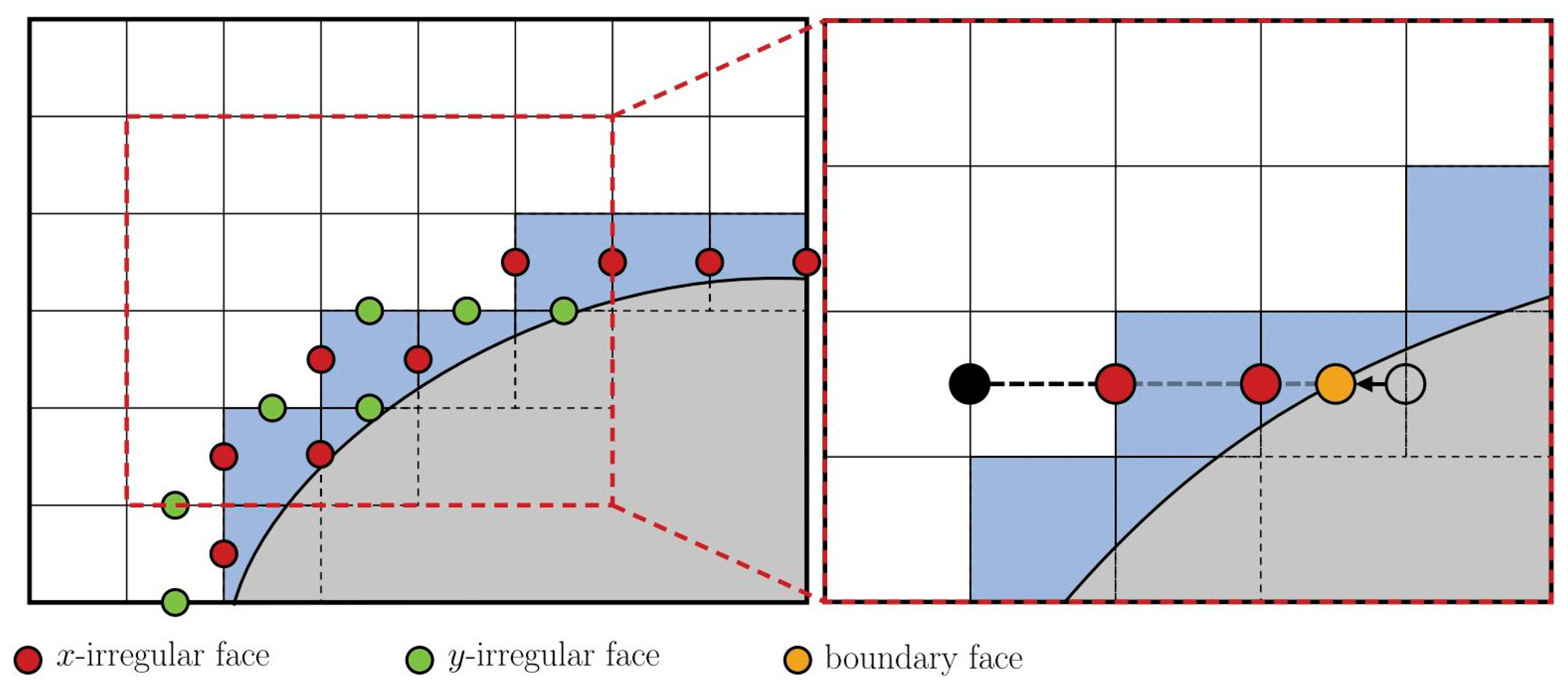

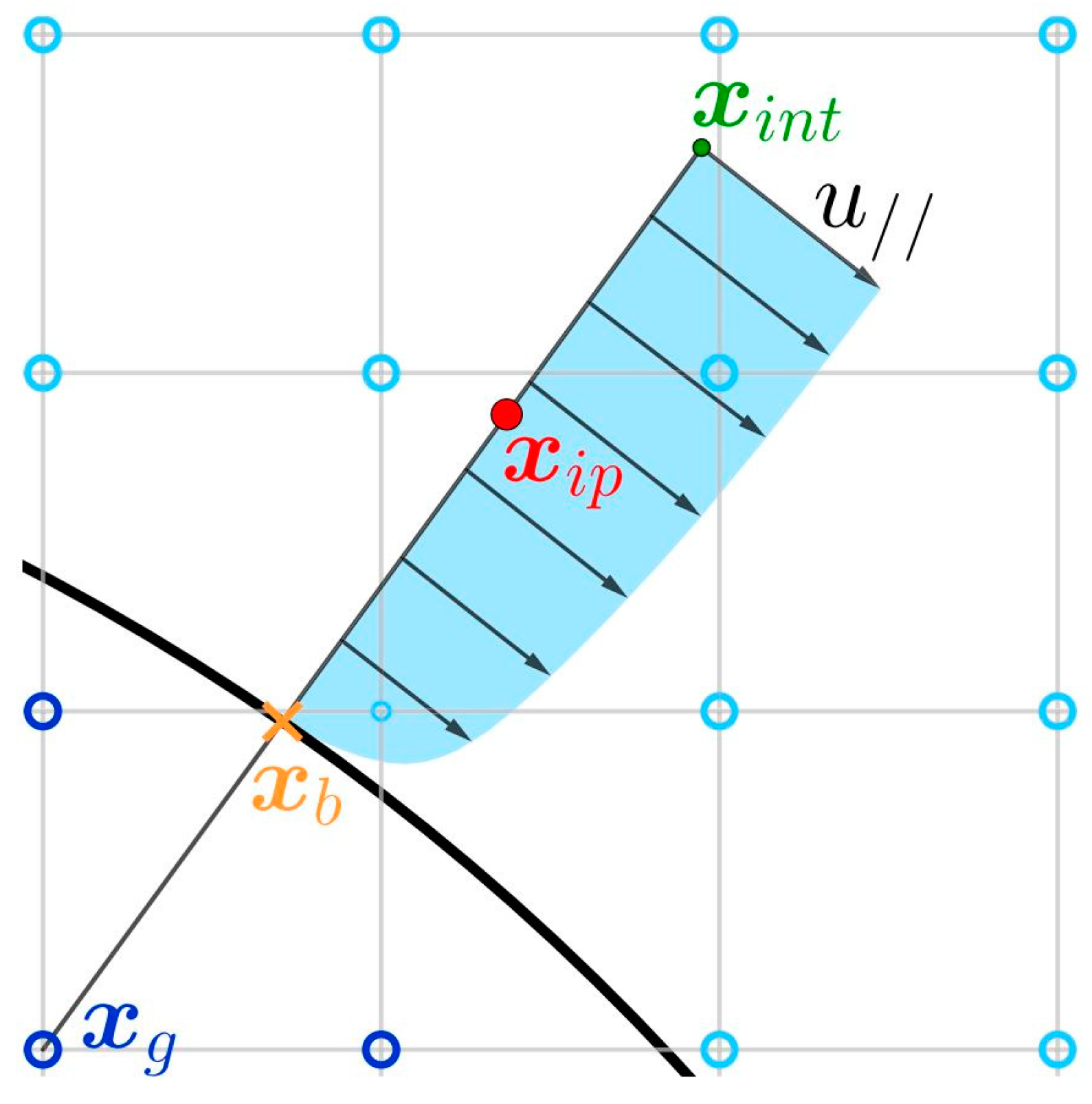
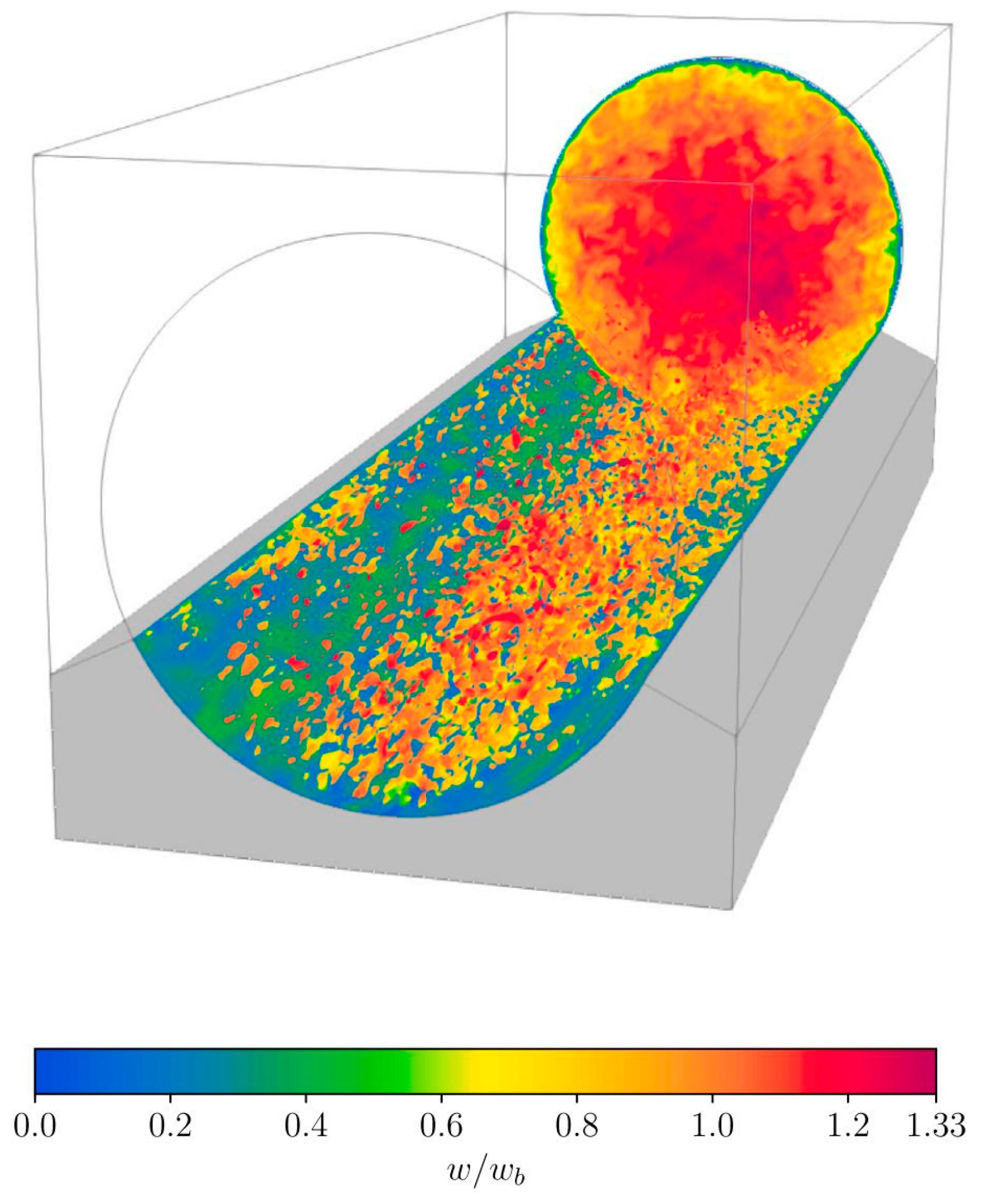
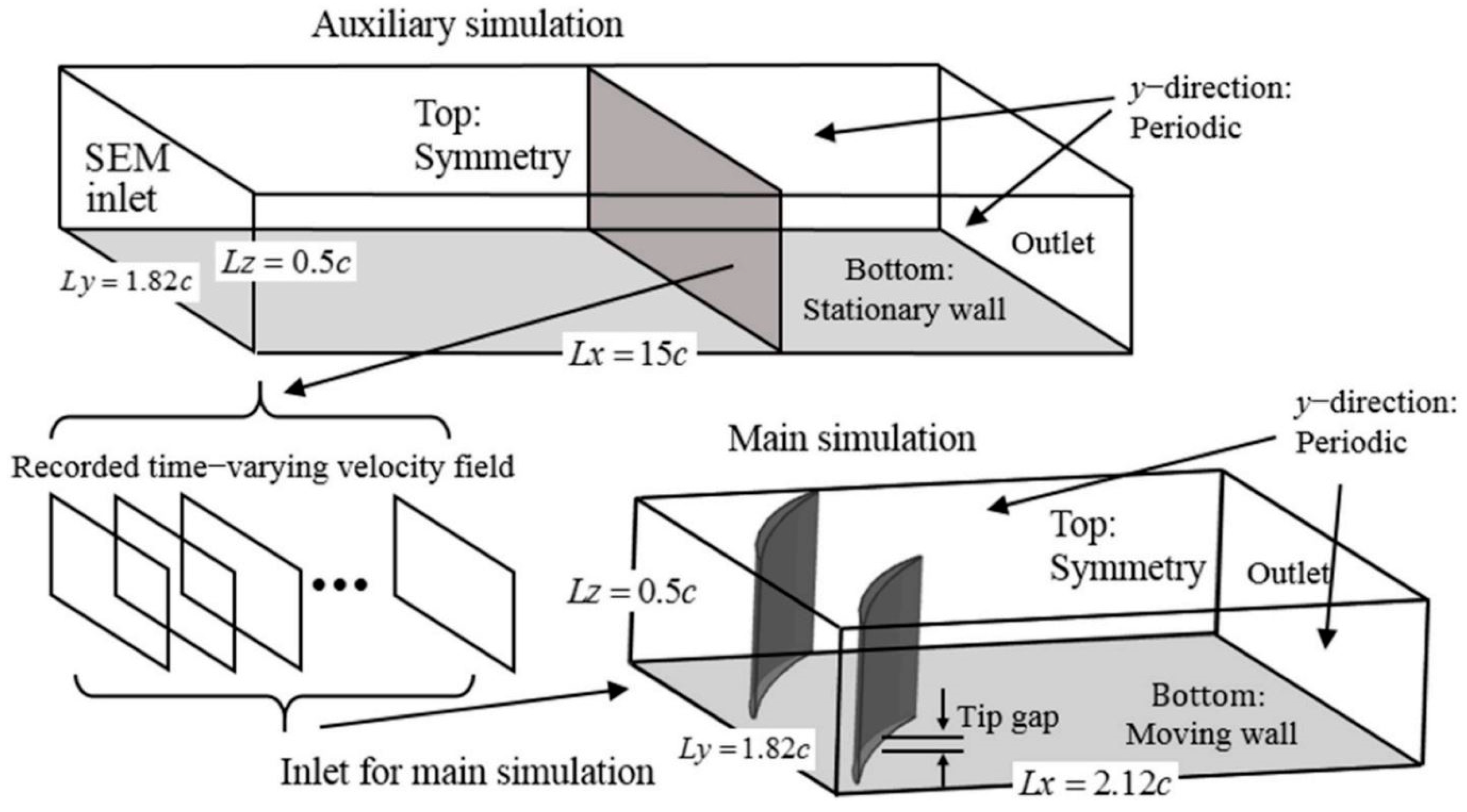

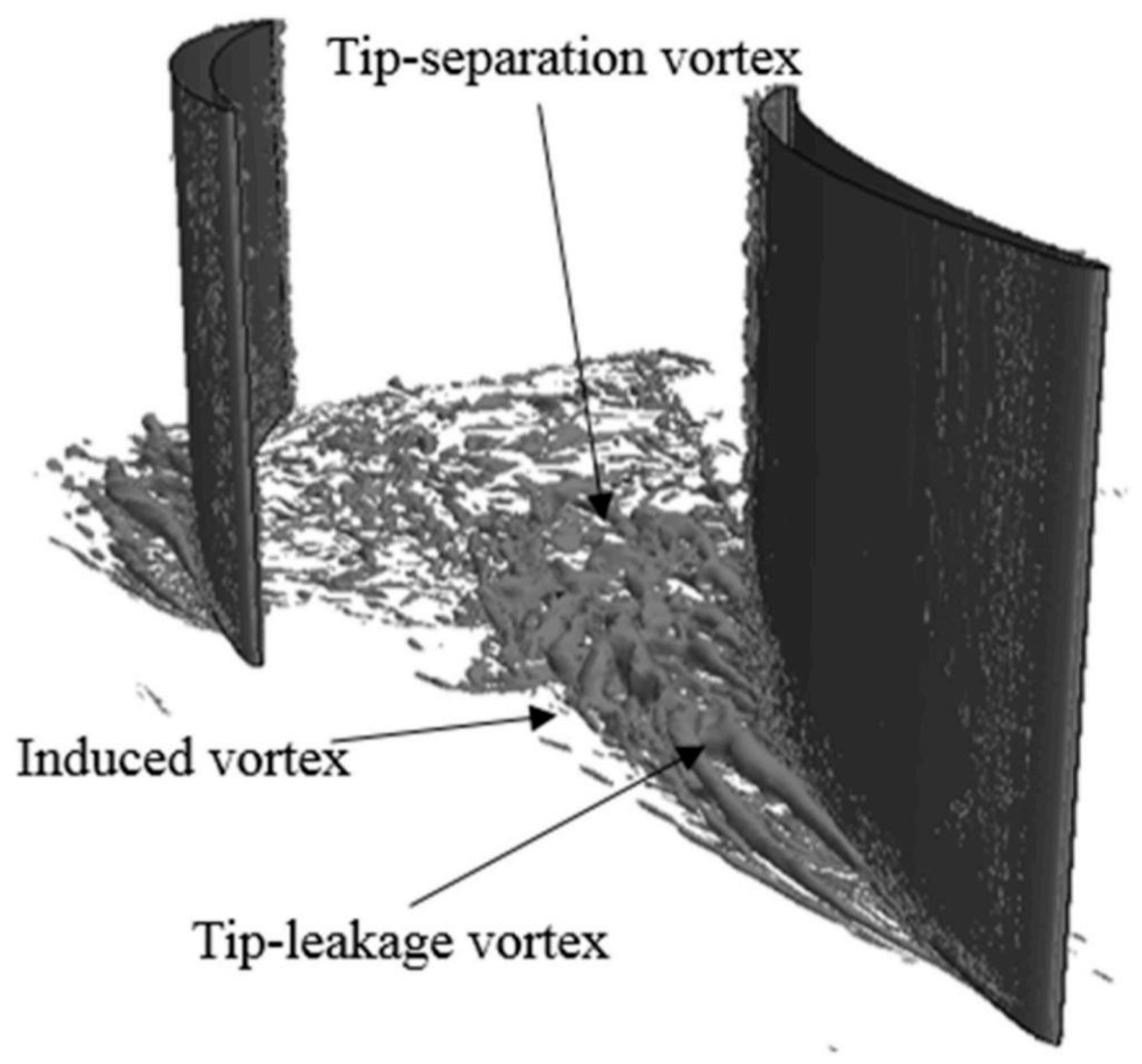
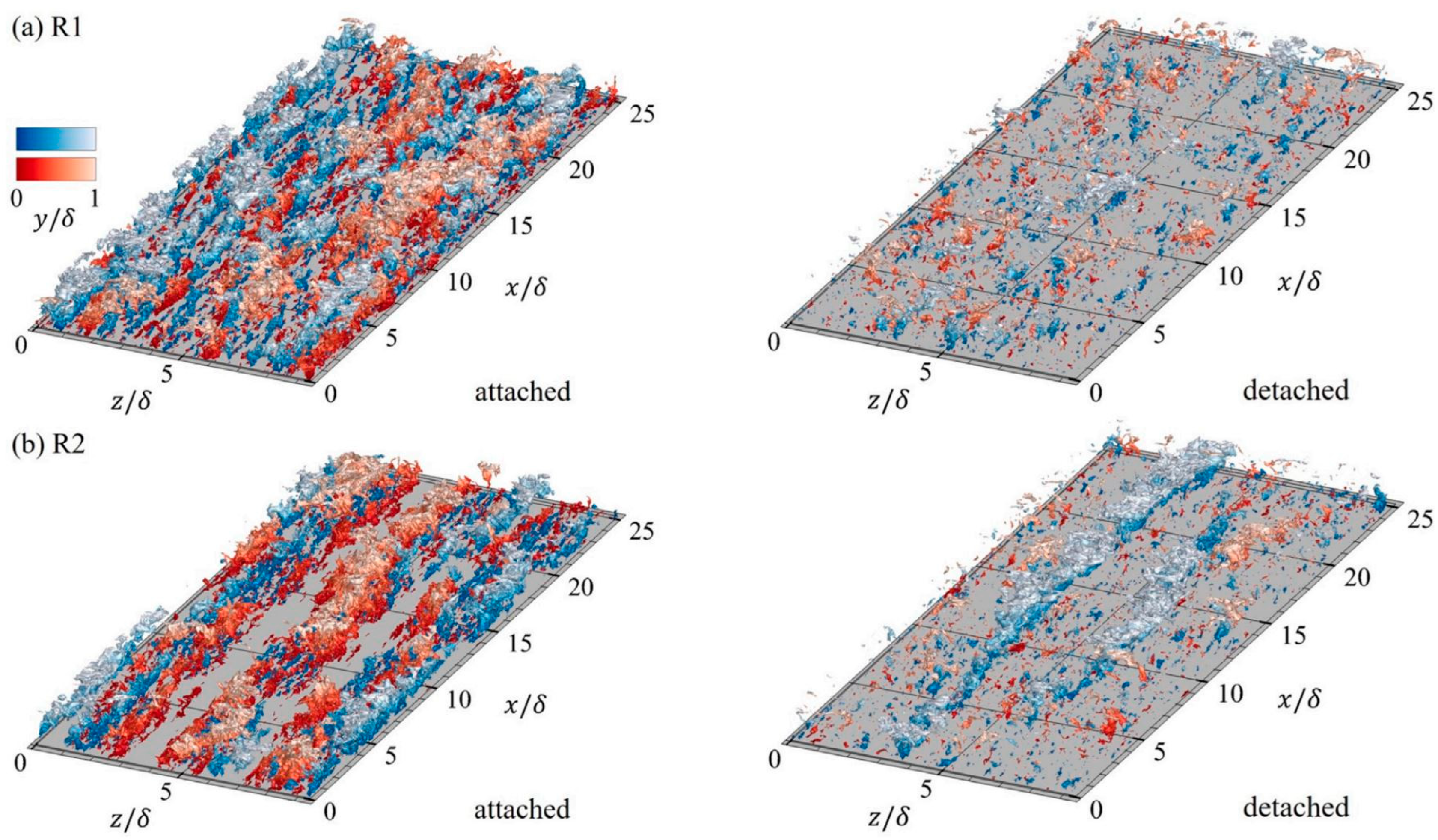
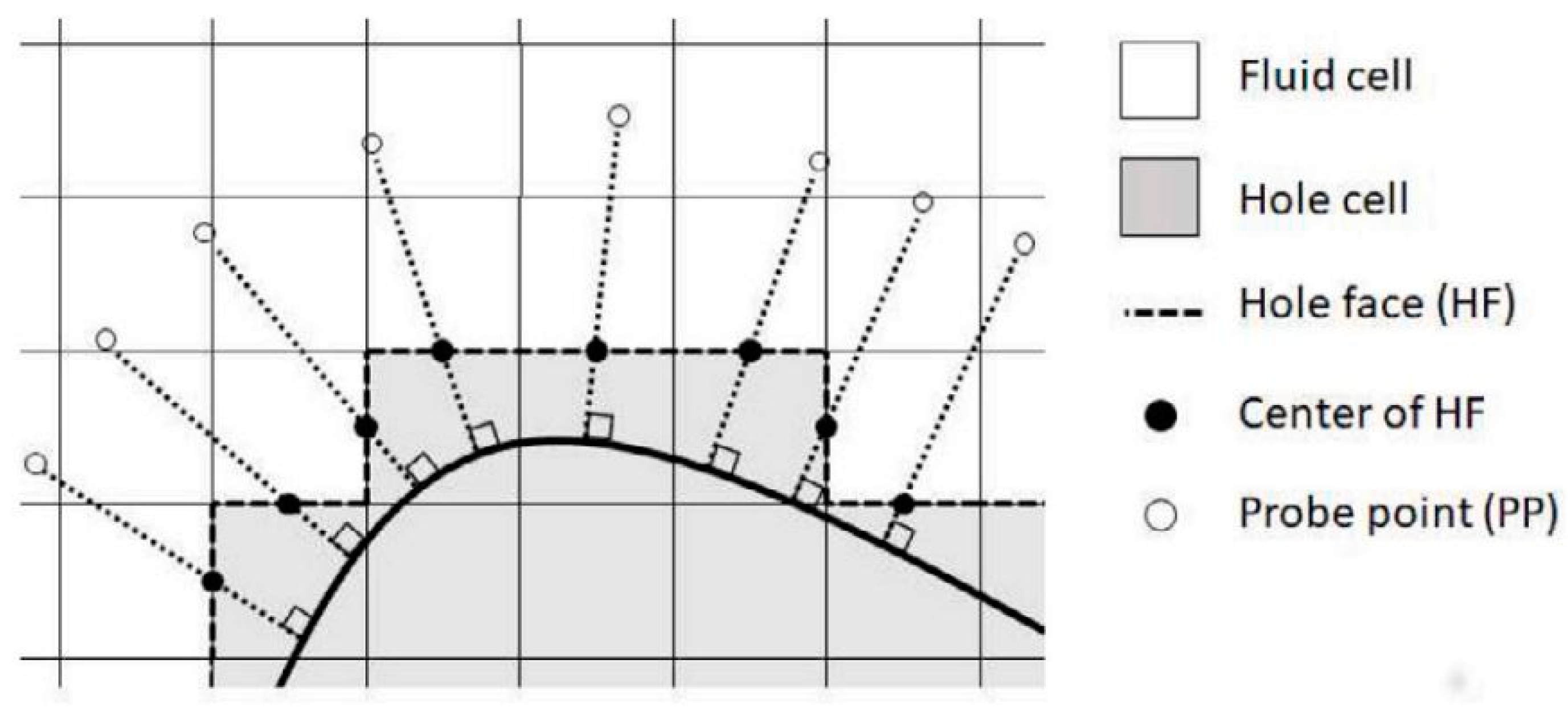

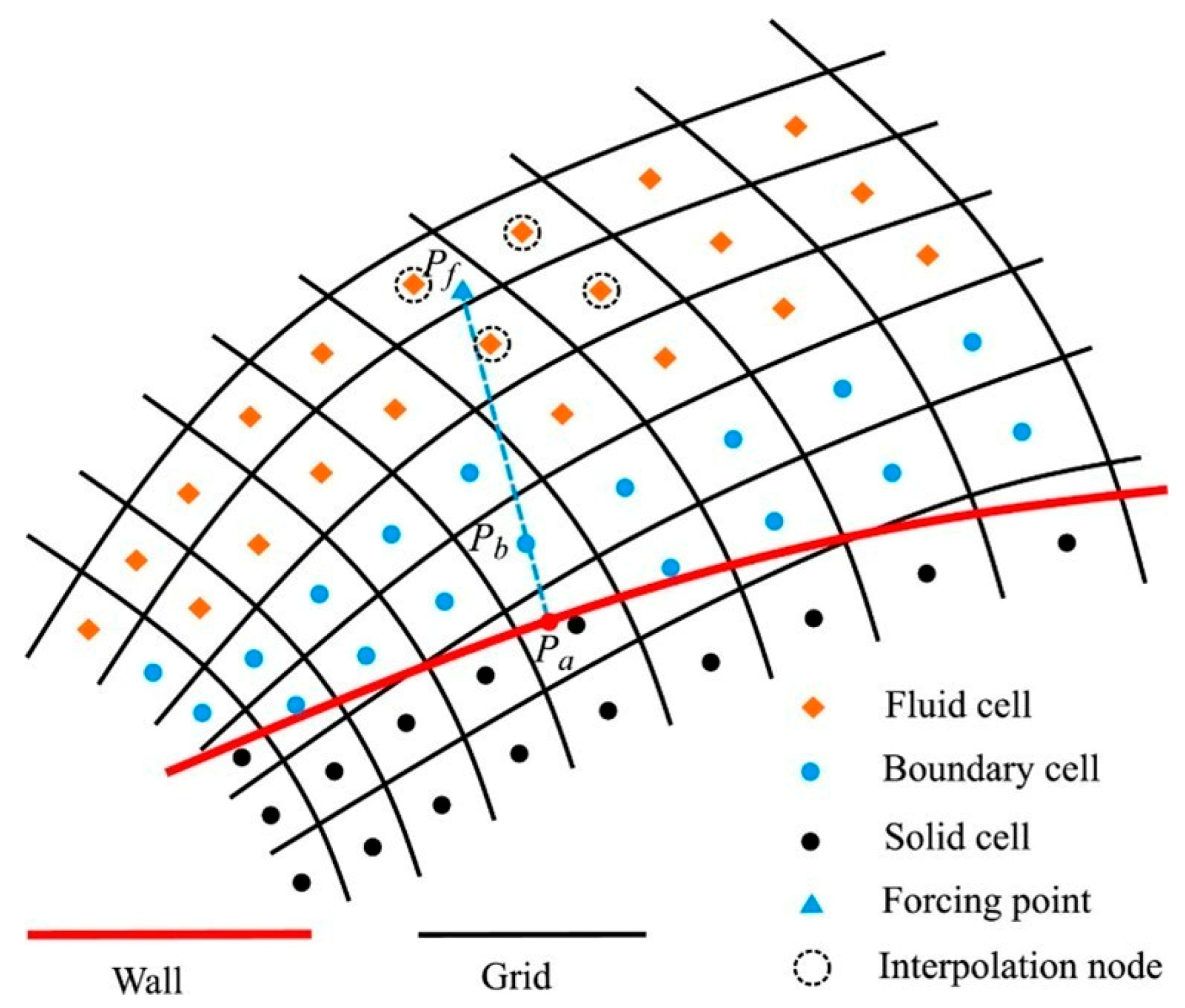
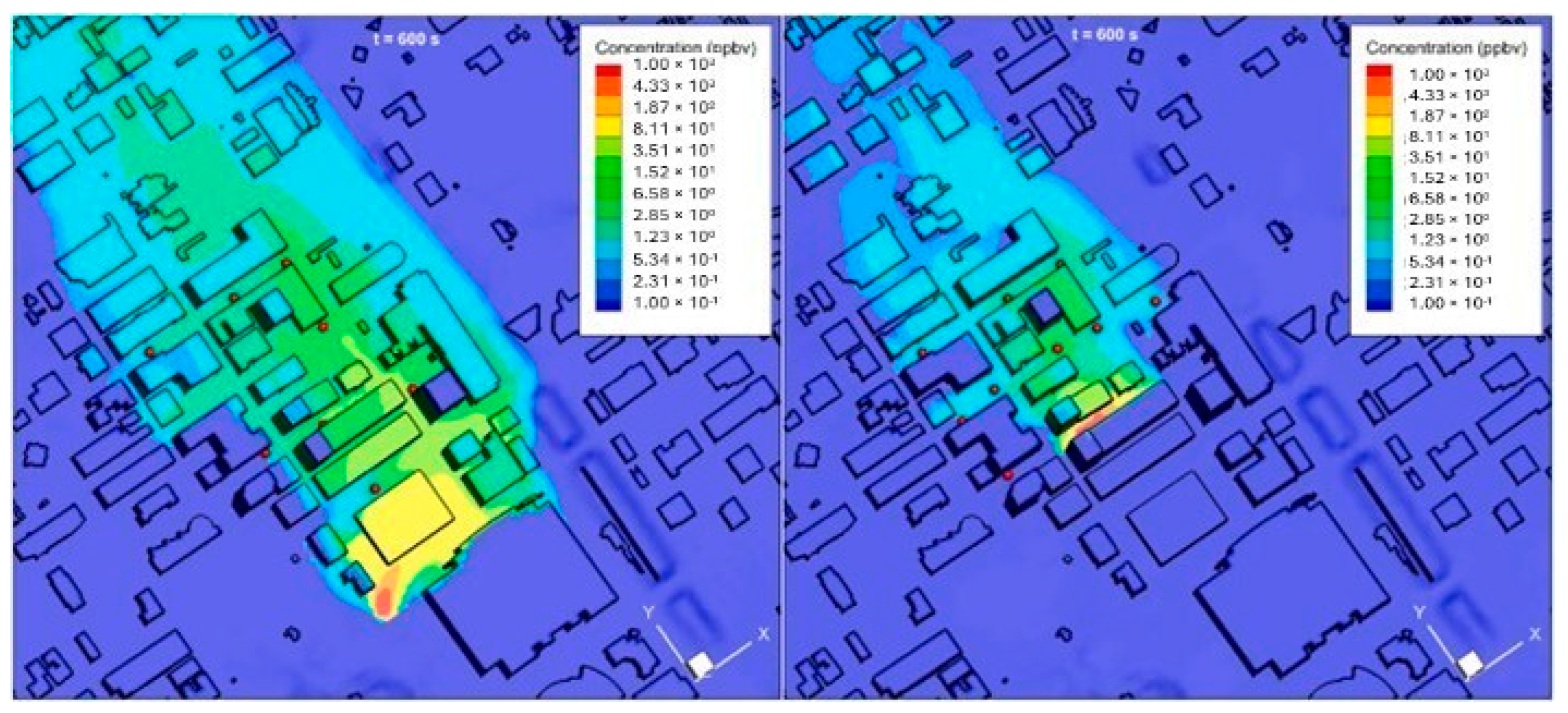
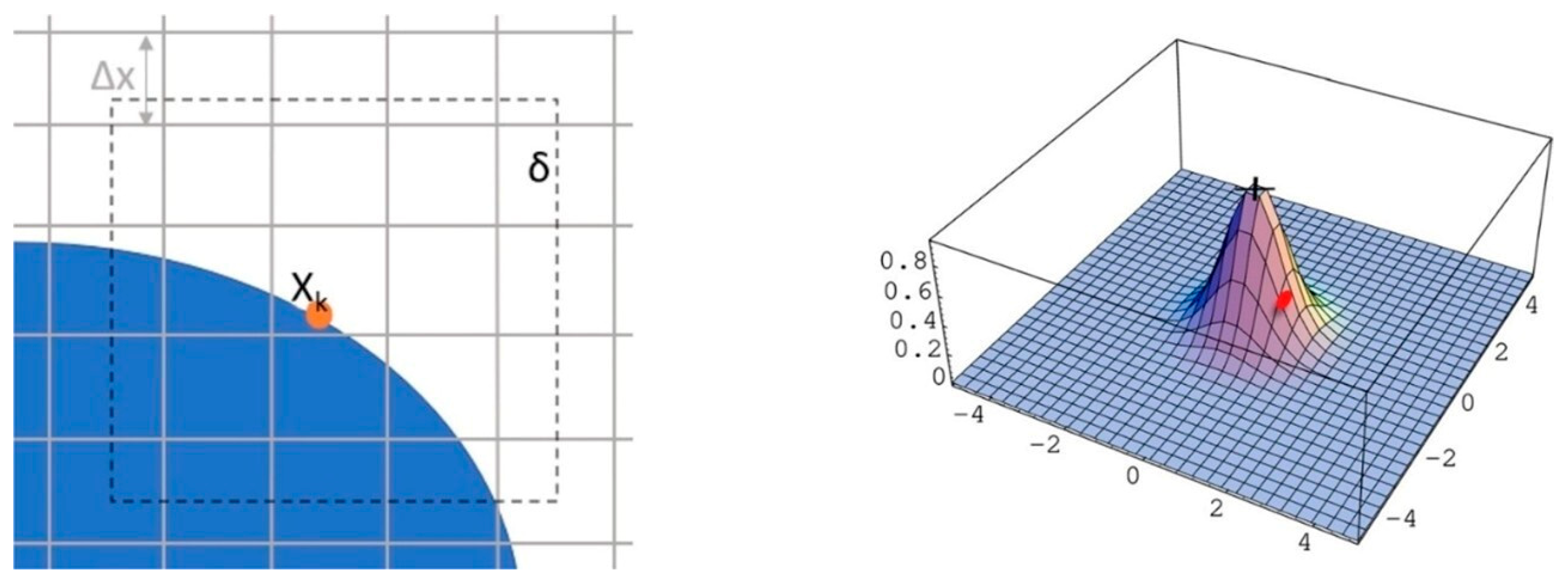
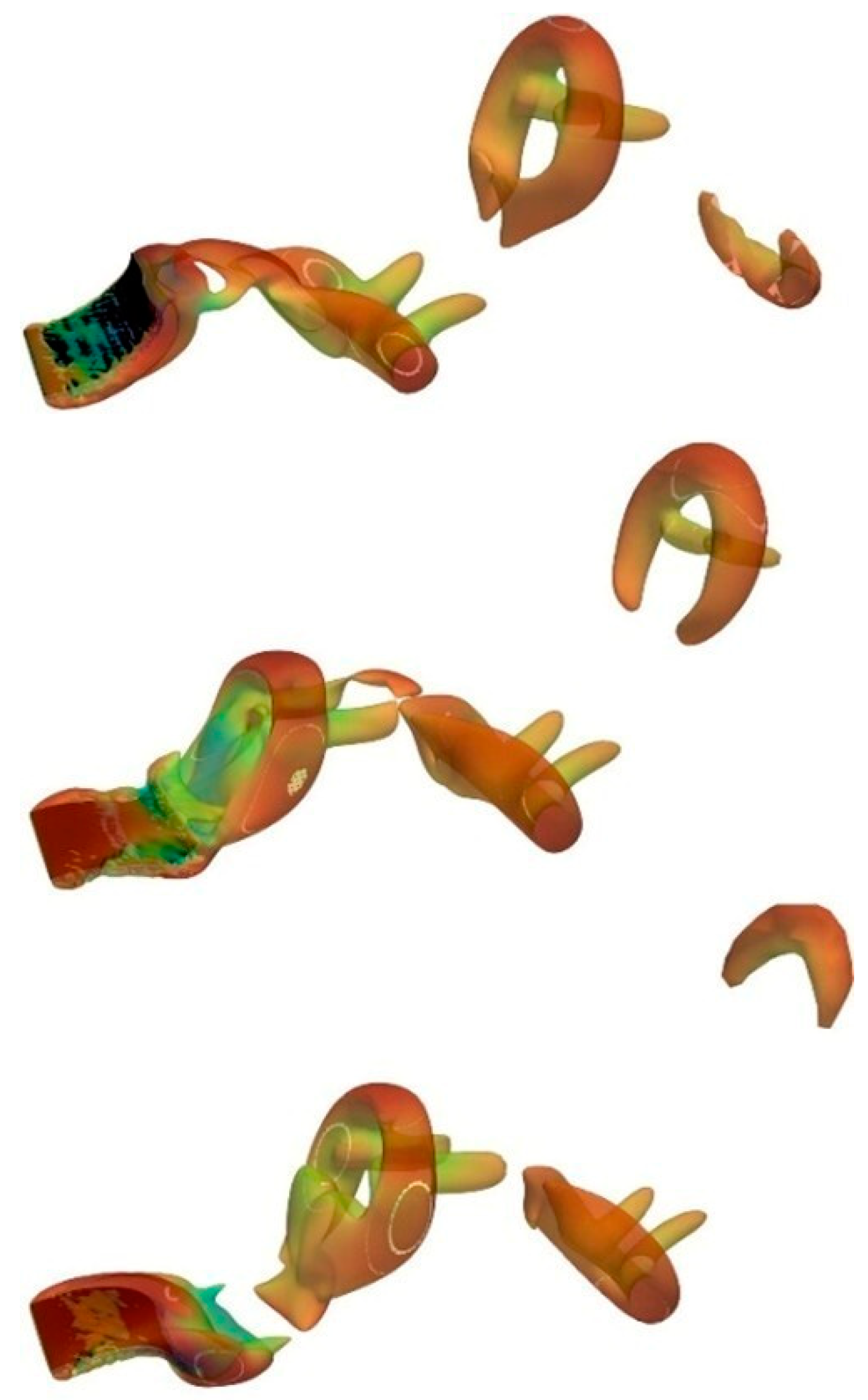
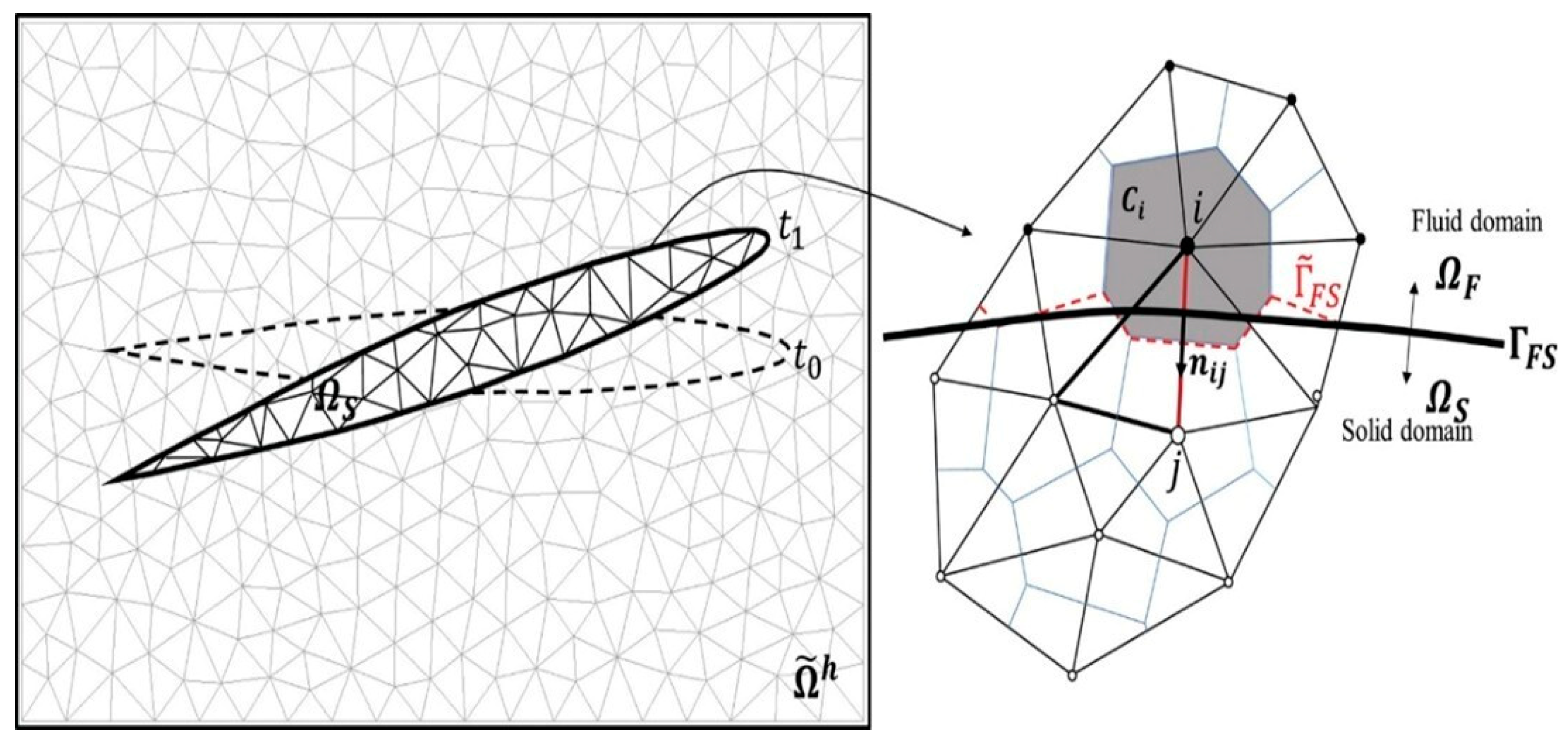
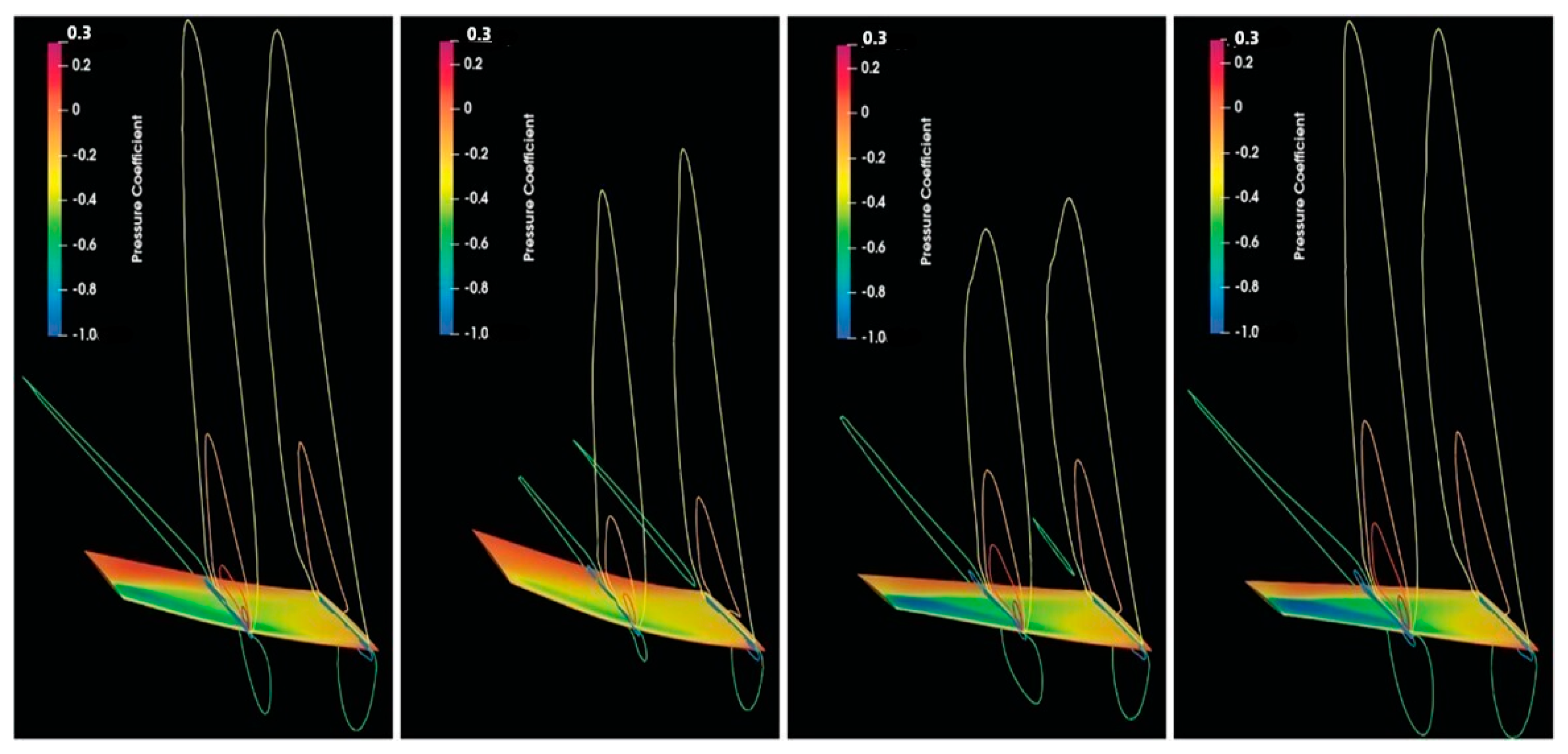
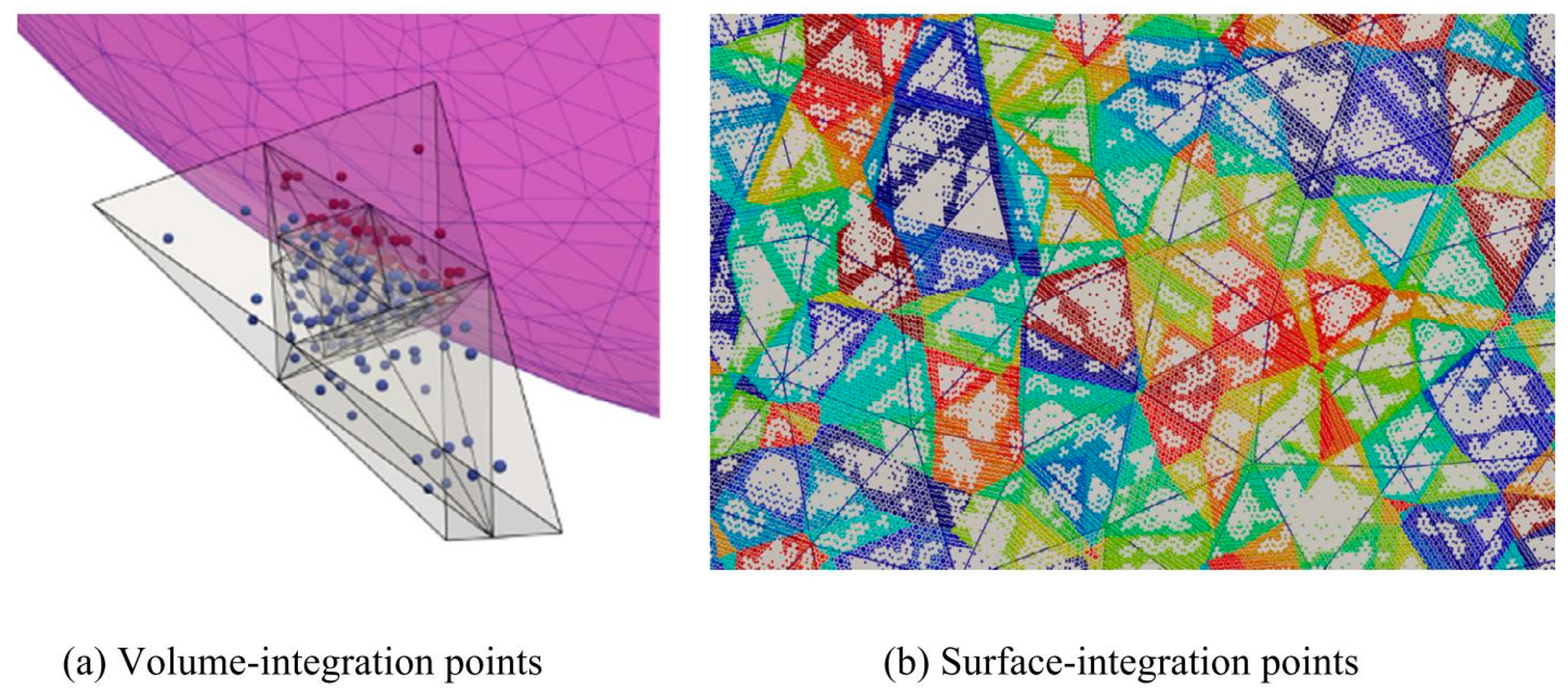

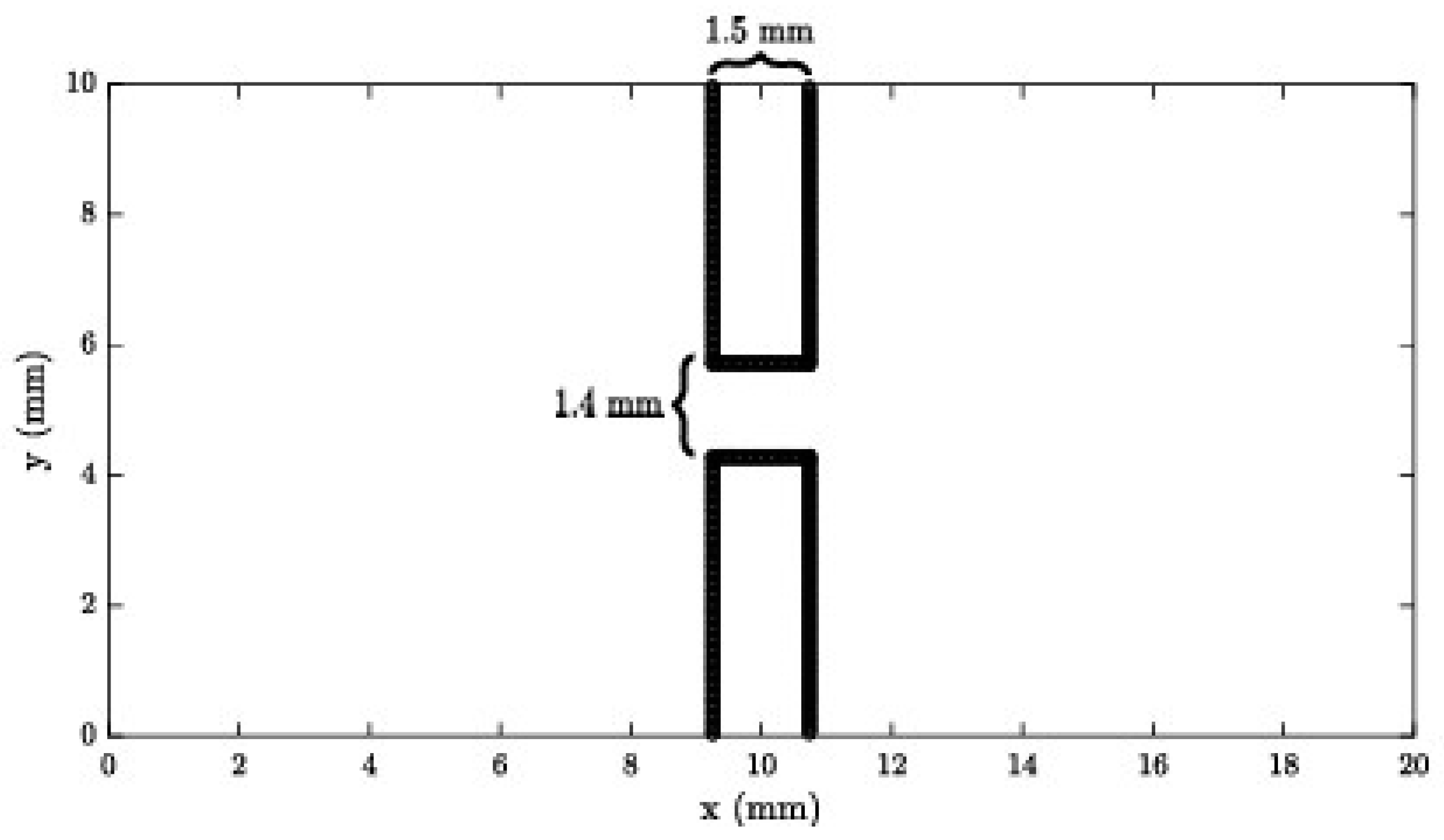
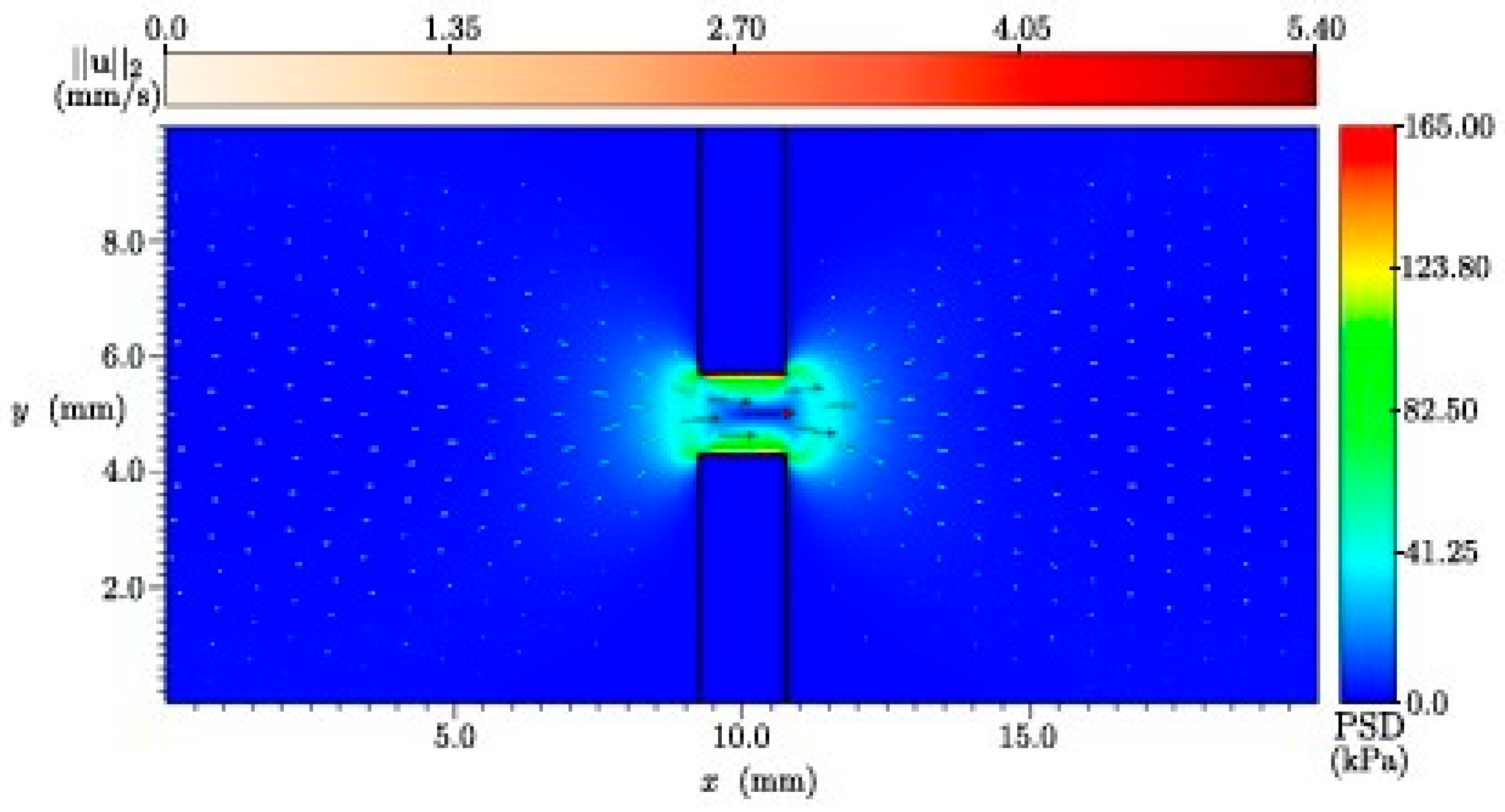

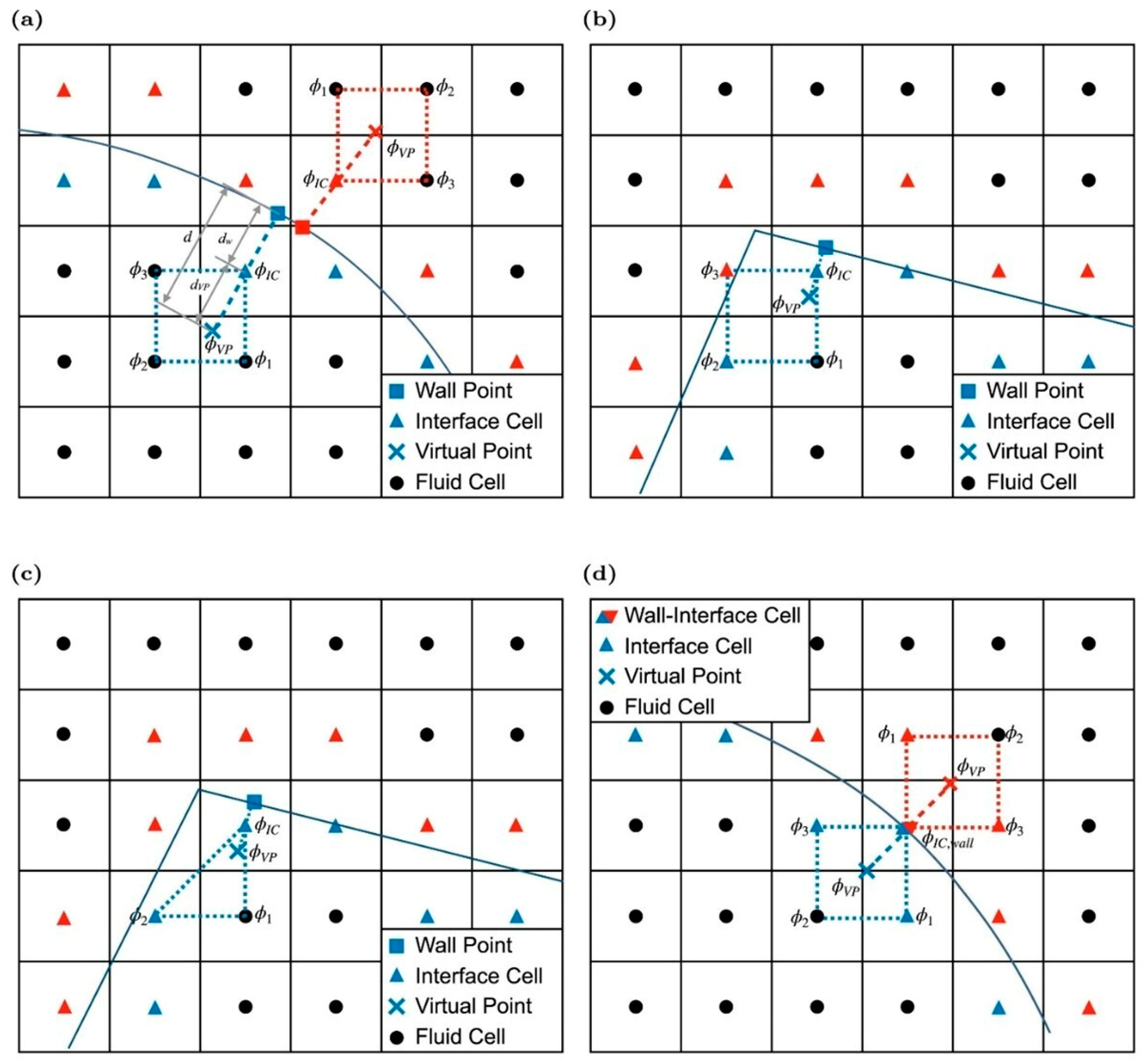
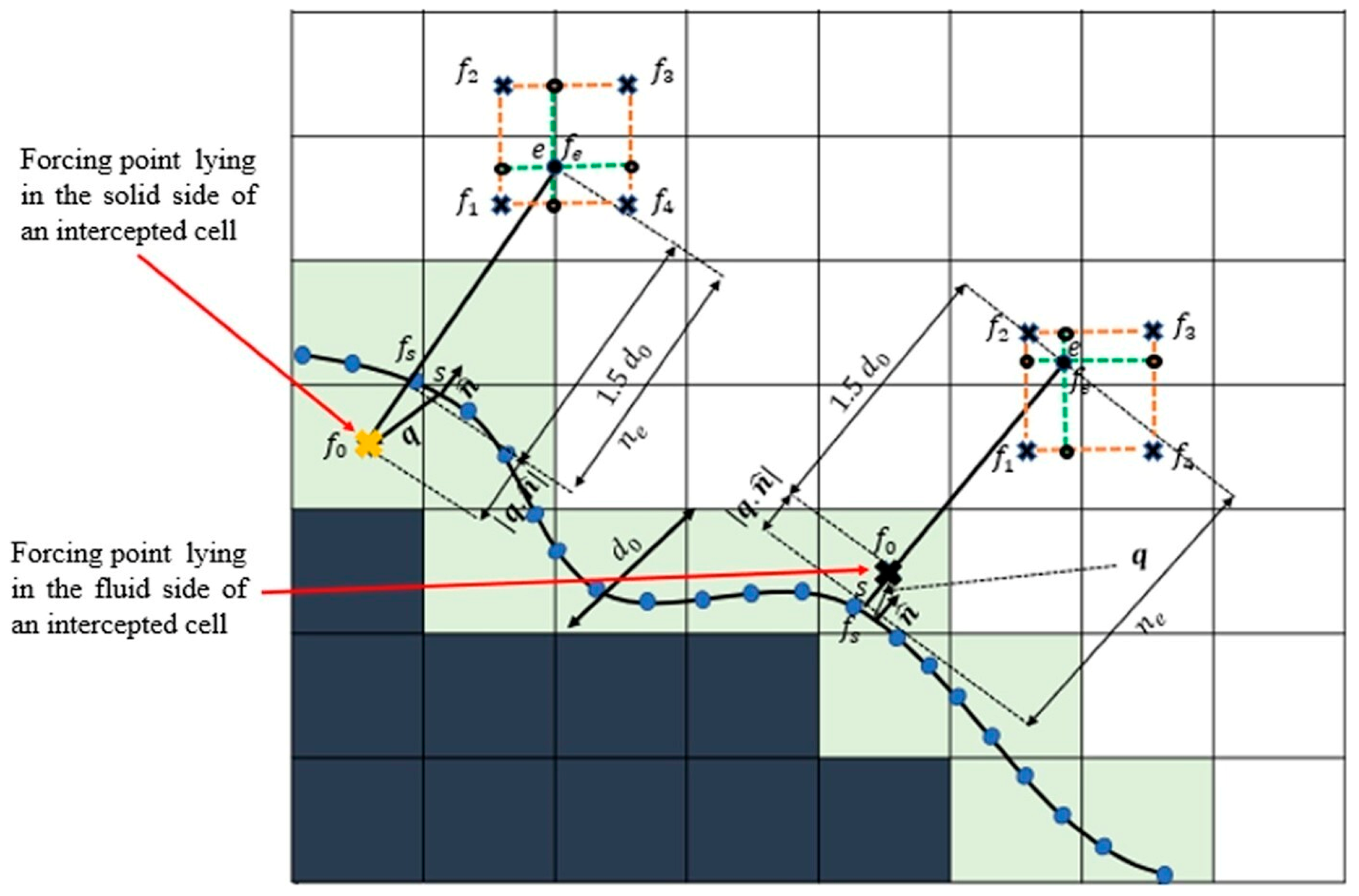


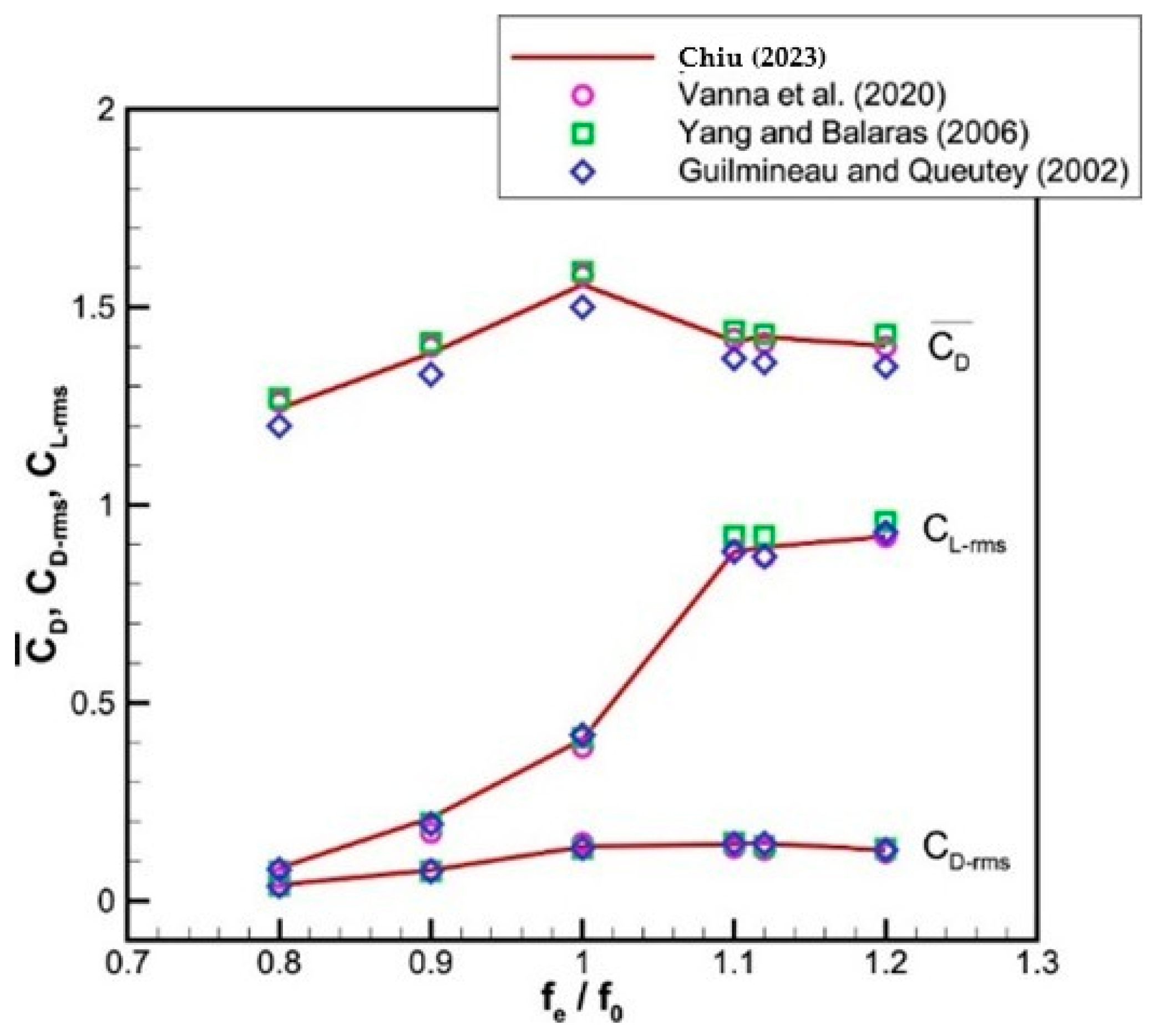
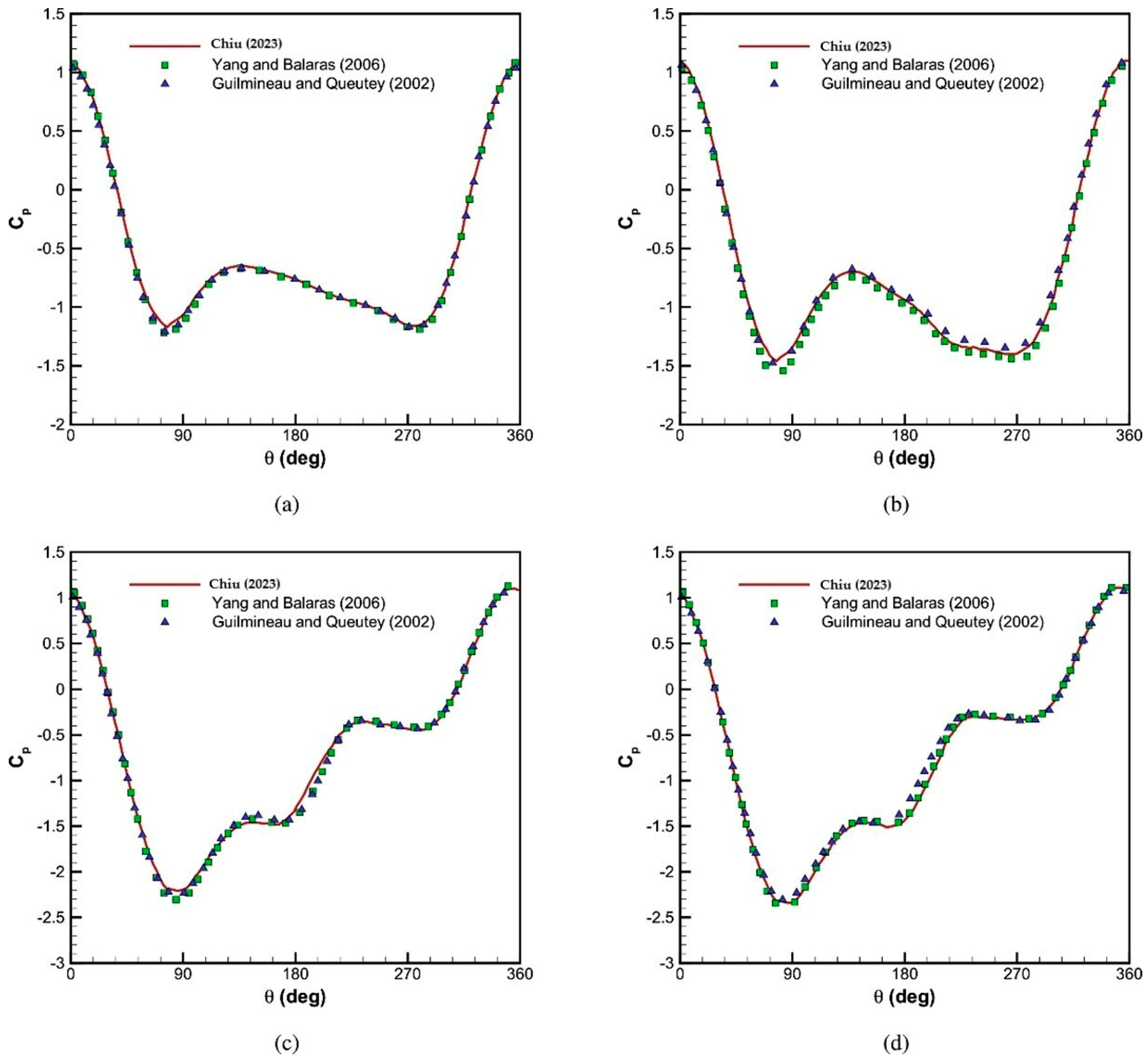


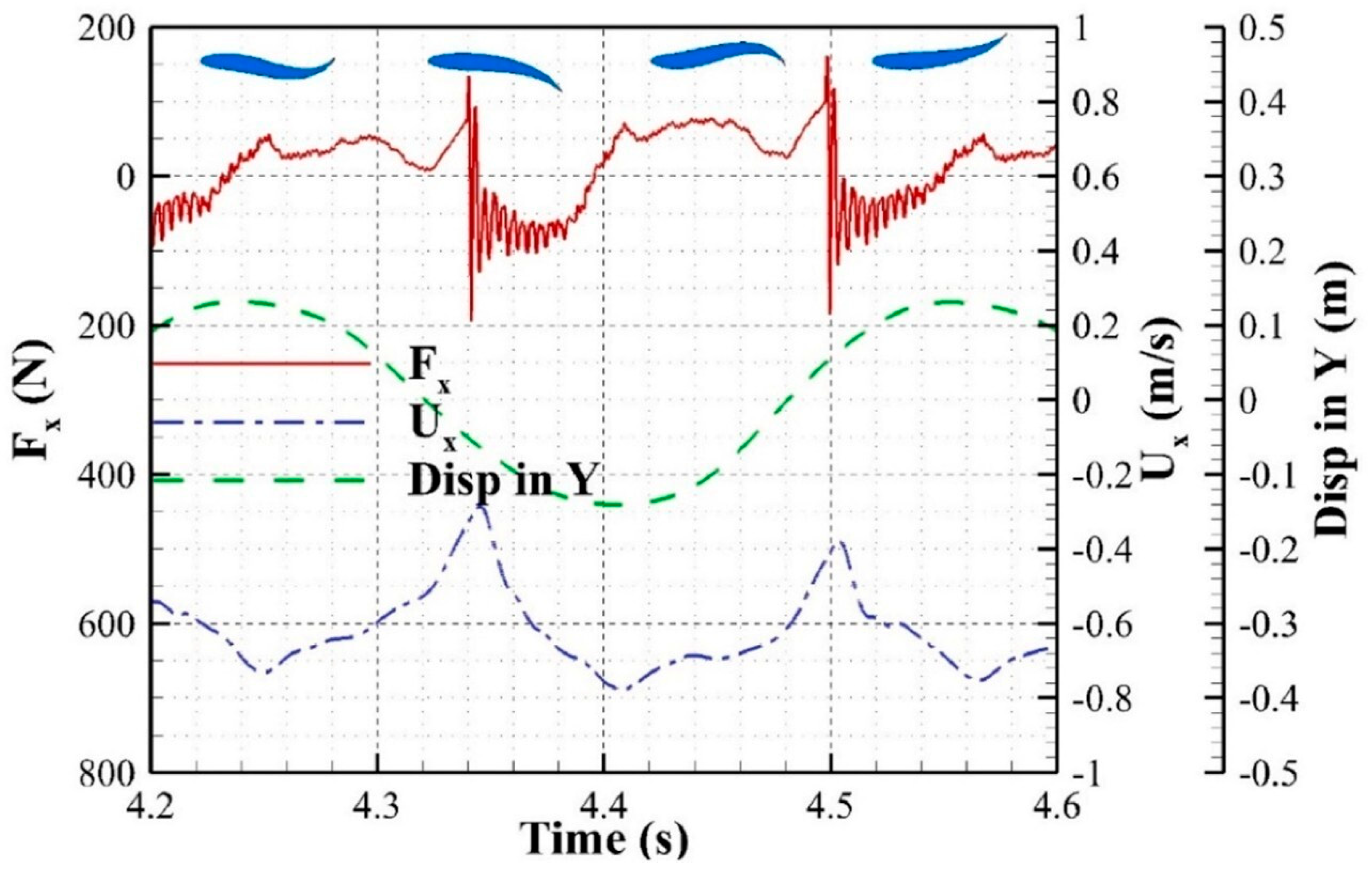
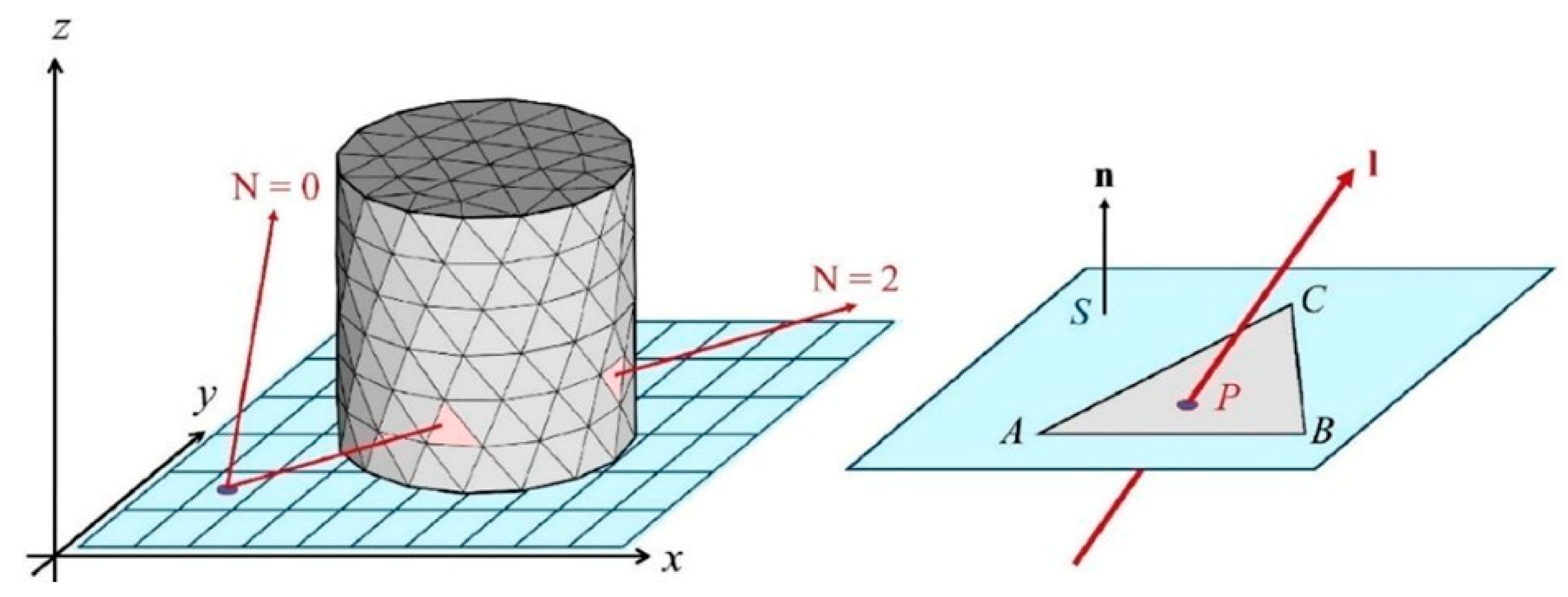
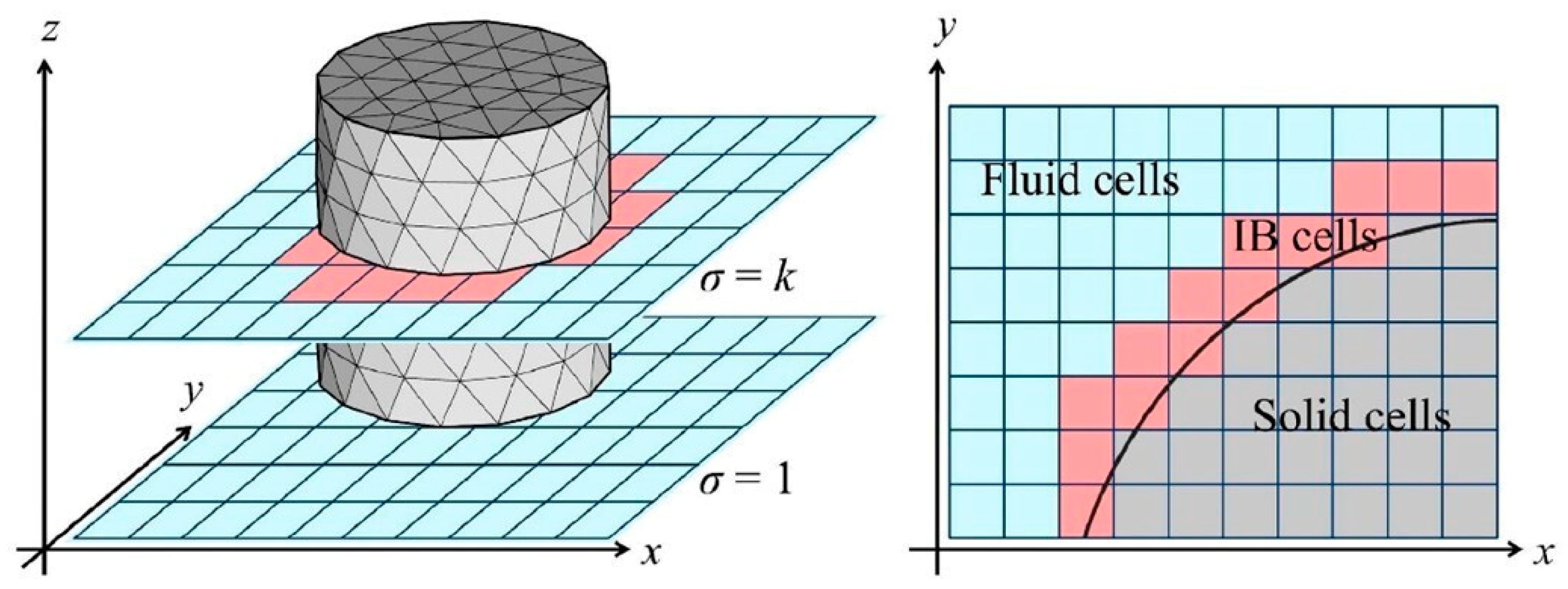

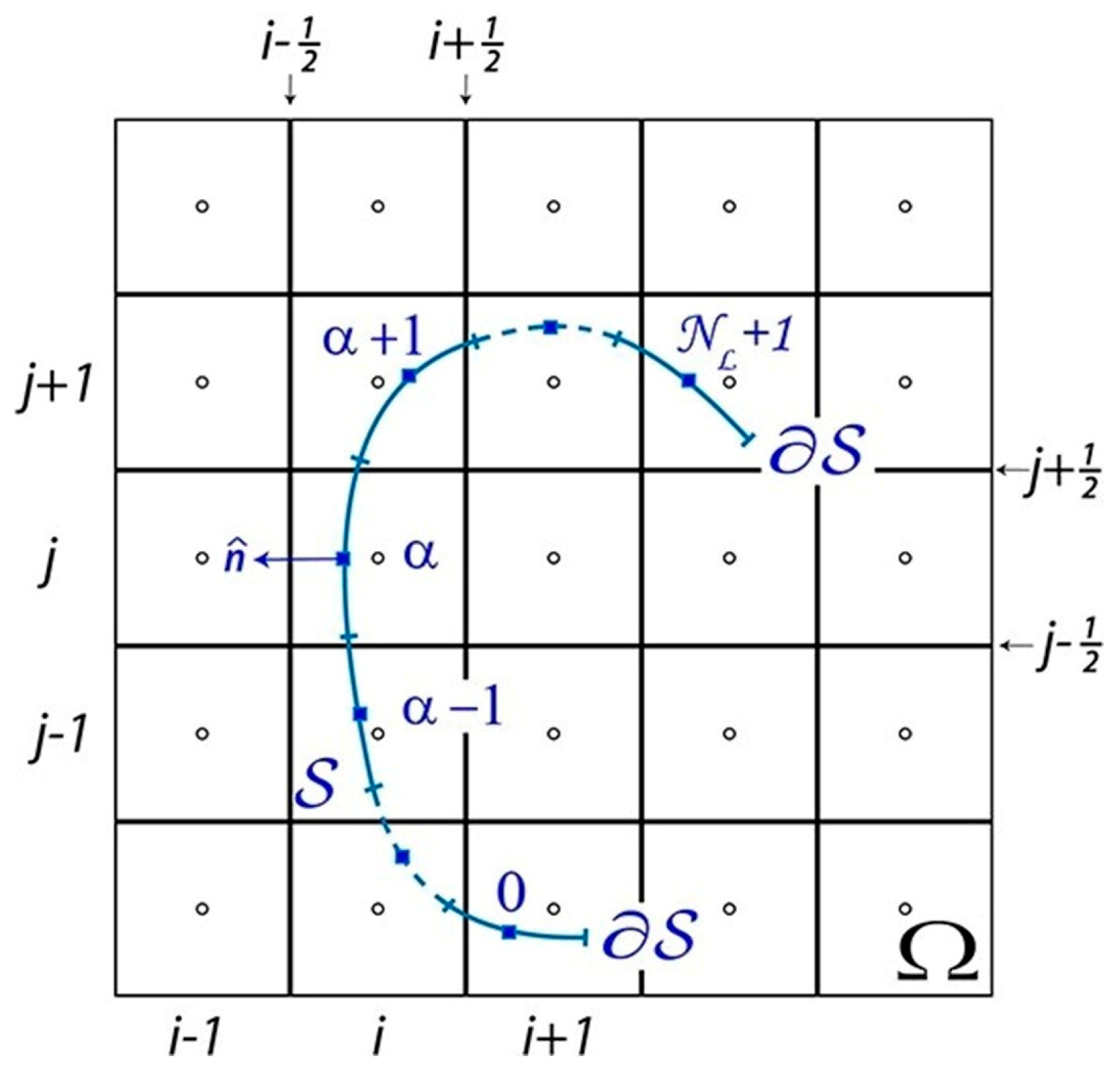
| Authors and Reference | Fluid Solver | IBM Methodology | Description | Application Area | Year |
|---|---|---|---|---|---|
| Choi et al. [10] | RANS (METIS) | Level-set IBM with power-law wall model | High-order schemes for 3D incompressible flows | High-Re turbulent flows | 2007 |
| De Tullio et al. [11] | RANS | Sharp-interface IBM with AMR | Local mesh refinement for compressible flows | Compressible steady flow past an NACA-0012 airfoil | 2007 |
| Ghosh et al. [12] | Hybrid LES/RANS | Perforated surface IBM | Shock–BL interaction with bleed modeling | Supersonic flows (Mach 2.5) | 2010 |
| Capizzano [13] | RANS | Two-layer wall-modeled IBM | Enhanced near-wall turbulence modeling | High-Re wall-bounded flows | 2011 |
| Bai et al. [14] | LES | Basic IBM-FVM coupling | Free surface MCT simulations | Marine turbines | 2014 |
| Specklin and Delauré [15] | OpenFOAM Hybrid LES/RANS | Penalization-based sharp IB | Verified with Wannier flow | Complex moving geometries | 2018 |
| Tamaki and Imamura [16] | RANS (METIS) | Wall-function IBM | Transonic turbulent flow solver | High-angle separation | 2018 |
| Xu et al. [17] | LBM | Adaptive-refinement IB-LBM | Geometry-adaptive grids | Wide-Re range flows | 2018 |
| Specklin et al. [18] | OpenFOAM (PIMPLE) + LBM | FSI-IBM coupling | Rag motion in rotating flows | Wastewater pumps | 2019 |
| Yoon et al. [19] | DNS | Wall-attached structure analysis | Classified turbulent structures in boundary layers | Turbulent boundary layers | 2020 |
| Wiersema et al. [20] | WRF Model | LES-IBM coupling | Enhanced urban terrain simulations | Weather forecasting | 2020 |
| Arthur et al. [21] | WRF Model | Velocity reconstruction IBM | Evaluated IB implementations in WRF | Atmospheric flows | 2020 |
| Wang et al. [22] | DNS | Wave–turbulence interaction | Studied energy transfer mechanisms | Surface wave flows | 2020 |
| Zhou et al. [23] | DNS | Lagrangian particle tracking | Investigated particle-laden flows | Channel turbulence | 2020 |
| Agarwal et al. [24] | LBM | IB-LBM with LES | Simulated flow past square cylinder | Turbulent duct flows | 2020 |
| Ma et al. [25] | DNS | Rough wall modeling | Examined roughness effects | Turbulent rough walls | 2020 |
| Hwang et al. [26] | DNS | Attached-eddy hypothesis | Analyzed TNTI structures | Wall turbulence | 2020 |
| Yang et al. [27] | DNS | TNTI analysis | Studied adverse pressure gradients | Boundary layers | 2020 |
| Wang et al. [28] | OpenFOAM (rhoCentralFoam) | Sharp-interface IBM | High-speed compressible flows | Hypersonic | 2020 |
| Zhang et al. [29] | Adaptive Tsinghua Turbulence Laboratory Large Eddy Simulation (ATTLES) | Weighted least square IBM | Hypersonic flow discontinuities | Shock waves | 2020 |
| Tsvetkova et al. [30] | Navier–Stokes system with Brinkman penalty | Topology-free IBM | Unstructured mesh adaptation | Moving bodies | 2020 |
| Onishi and Tsubokura [31] | LES | Ghost-cell TF-IBM | “Dirty” CAD geometry handling | Industrial flows | 2021 |
| Tamaki and Imamura [32] | Roe’s approximate Riemann solver | Dimension-by-dimension reconstruction | Quadrature modified flux | NACA Airfoil | 2018 |
| Chen et al. [33] | URANS | Tamaki wall–model IBM | Rotor/stator interactions | Turbomachinery | 2021 |
| Liao and Yang [34] | Newton-Krylov | CURVIB method | Near-wall turbulence prediction | Curvilinear flows | 2021 |
| Cai et al. [35] | SA-fv3 | Wall–model coupling | High-Re modifications | Cartesian grids | 2021 |
| Ma et al. [36] | LES | Hybrid IBM–wall model | High-Re turbulent flows | Wall-bounded flows | 2021 |
| Xu and Liu [37] | RANS | y+-adaptive IBM | Smooth wall shear stress | Complex geometries | 2021 |
| Wang and Gorlé [38] | LES | Direct forcing IBM | Atmospheric boundary layer | Wake dynamics | 2024 |
| Kang et al. [39] | DNS | Many-core optimization | Intel Xeon Phi implementation | High-performance CFD | 2021 |
| Choung et al. [40] | Euler Equation solver | NWIBM | Nonlinear weighting process | Compressible flows | 2021 |
| Constant et al. [41] | RANS | Improved Cartesian IBM | Spurious oscillation reduction | Turbulent flows | 2021 |
| Wang et al. [42] | LES | Wavy boundary analysis | Wall-attached structures | Traveling waves | 2021 |
| Bale et al. [43] | Second-order accurate pressure projection algorithm | MLS one-sided IBM | Simplified meshing approach | Fluid interactions | 2021 |
| Giannenas and Laizet [44] | DNS | Cubic spline IBM | Fixed/moving objects | Cartesian meshes | 2021 |
| Kubo et al. [45] | RANS (k-ω SST) | Level-set topology IBM | 2D turbulent flow optimization | Aerodynamics | 2021 |
| Troldborg et al. [46] | RANS/DES | Tree skeleton IBM | Wind force prediction | Forest meteorology | 2021 |
| Kasbaoui et al. [47] | DNS | Semi-implicit MIBM | Swirling von Kármán flow | Vortex dynamics | 2021 |
| Cui et al. [48] | DNS | Particle tracking IBM | Fiber/disk alignment | Multiphase flows | 2021 |
| Sugaya et al. [49] | RANS/DDES-p | High-order scheme IBM | Moving Cartesian grids | Unsteady flows | 2021 |
| Lin et al. [50] | HLCC Riemann solver | Transient flow IBM | Solid rocket motors | Combustion chambers | 2021 |
| Cao and Huang [51] | Exact Riemann solver | Bayesian calibration IBM | Unscented Kalman filter for uncertainty analysis | Transonic buffeting | 2021 |
| Secchi et al. [52] | DNS | IBM vs. PFA comparison | Jet impingement on rough plates | Turbulent jets | 2021 |
| Atmani et al. [53] | LES | Hybrid IBM-LES | High-Re pipe flows on coarse grids | Wall-bounded turbulence | 2021 |
| Kang and Masud [54] | GMRES | Variational IBM | Weak boundary enforcement | Train aerodynamics | 2021 |
| Giannenas et al. [55] | InCompact3D | ADR-IBM with CAD/ALM | 1D cubic spline reconstruction | Rotor aerodynamics | 2021 |
| Shallcross et al. [56] | Navier–Stokes system with Brinkman penalty | Characteristic-based penalization | Compressible Euler/NS equations | Hypersonic | 2021 |
| Jiang et al. [57] | LES | Tip-gap flow IBM | TLV trajectory analysis | Turbomachinery | 2021 |
| Park et al. [58] | OpenFOAM Hybrid LES/RANS | Wall-function IBM | Rotorcraft/ship air wakes | High-Re external flows | 2021 |
| Troldborg et al. [59] | RANS | Two wall-function IBM | Near-wall flow modeling | Aerodynamics | 2021 |
| de Albuquerque et al. [60] | RANS | IMERSPEC | IMERSPEC combined with the Spalart–Allmaras turbulence model | Fully developed channel flow | 2021 |
| Du et al. [61] | RANS | DI-IBM with auxiliary layers | High-Re turbulent flows | Boundary layers | 2022 |
| Van Noordt et al. [62] | WMLES | Hypersonic IBM | Shock–boundary layer interaction | Hypersonic flows | 2022 |
| Mitkov et al. [63] | RANS | IBOFlow® solver | Urban wind simulations | Microclimate | 2022 |
| Unglehrt et al. [64] | MGLET | Symmetry-preserving IBM | 3D extension with cell merging | General CFD | 2022 |
| Capuano et al. [65] | OpenFOAM (PIMPLE) | Comparative IBM study | Sphere flow at Re = 3700 | Separated flows | 2022 |
| /Nek5000) | |||||
| Ryan et al. [66] | RANS | Cartesian mesh IBM | CBR dispersion modeling | Public safety | 2022 |
| Kubíčková and Isoz [67] | OpenFOAM (SIMPLE) | HFDIB method | Topology optimization | Geometry simplification | 2022 |
| Chen et al. [68] | URANS | Wall-function IBM | ANCF rotor validation | Fan aerodynamics | 2022 |
| Wang et al. [69] | URANS | AFD-IBM technique | Aero-engine internal flows | Turbomachinery | 2022 |
| Cai et al. [70] | Hybrid RANS-LES | Wall-modeled IBM | Spurious oscillation reduction | Complex geometries | 2022 |
| Ma et al. [71] | LES | Roughness IBM | 3D bump effects | Channel flows | 2022 |
| Ma et al. [72] | DNS | Roughness IBM | Secondary motion analysis | Wall turbulence | 2022 |
| Lin et al. [73] | HLCC Riemann solver | 3D fixed-boundary IBM | Solid rocket motors | Combustion | 2023 |
| Cheylan et al. [74] | LBM | Lagrangian weight IBM | 20% error reduction in FSI | Moving boundaries | 2023 |
| Başkaya et al. [75] | Mutation++ | CNE/GSI IBM | Atmospheric entry | Hypersonic re-entry | 2023 |
| De Vanna et al. [76] | WMLES | SI-IBM with Cartesian grids | High-speed complex flows | Aerospace | 2023 |
| Authors and Reference | Fluid Solver | Summary | Application Area | Year |
|---|---|---|---|---|
| Lai and Peskin [79] | Spectral | Second-order IBM with reduced numerical viscosity | General CFD | 2000 |
| Griffith and Peskin [80] | Projection Method | Higher-order accuracy analysis for smooth problems | FSI | 2005 |
| Pan [81] | Fractional Step | Volume-of-body function approach | Incompressible flows | 2005 |
| Taira and Colonius [82] | Fractional Step | Immersed boundary projection approach | General CFD | 2007 |
| Shin et al. [83] | Fractional Step | Assessment of regularized delta functions | IB forcing schemes | 2008 |
| Ji et al. [84] | Fractional Step | Iterative direct-forcing IB method | Finite volume | 2012 |
| Valero-Lara [85] | Lattice Boltzmann | GPU-accelerated IB-LBM | Solid–fluid interaction | 2014 |
| Dash et al. [86] | Lattice Boltzmann | Flexible forcing 3D IB-LBM | Flow past spheres | 2014 |
| Valero-Lara et al. [87] | Lattice Boltzmann | Heterogeneous platform acceleration | Solid–fluid interaction | 2014 |
| Valero-Lara et al. [88] | Lattice Boltzmann | Optimized for NVIDIA GPUs/Xeon Phi | Solid–fluid interaction | 2015 |
| Wang et al. [89] | LES | Implicit direct forcing IBM for complex flows | Moving boundaries | 2017 |
| Kefayati et al. [90] | Lattice Boltzmann | IB-FD-LBM for viscoplastic fluids | Fluid–structure interaction | 2018 |
| Stein et al. [91] | Spectral | Immersed boundary smooth extension | Polymeric flows | 2019 |
| Dash [92] | Lattice Boltzmann | Flexible forcing IB-SLBM | 2D/3D FSI | 2019 |
| Tao et al. [93] | Lattice Boltzmann | Non-iterative IB-LBM | Fluid–solid flows | 2019 |
| Peng et al. [94,95] | Lattice Boltzmann | IBM vs. bounce-back schemes | Curved surfaces | 2019 |
| Vadala-Roth et al. [96] | IBAMR | Stabilized hyperelastic IBM | Large deformation | 2020 |
| Ma et al. [97] | Lattice Boltzmann | IB-LBM for viscoelastic fluids | Complex FSI | 2020 |
| Bale et al. [98] | Projection Method | Constraint IBM with stencil penalization | Neumann BCs | 2020 |
| Zhang et al. [99] | Lattice Boltzmann | Relaxed multi-direct-forcing IB-LBM | GPU acceleration | 2020 |
| Zhou et al. [100] | Fractional Step | Divergence-free IBM | Incompressible flows | 2020 |
| Wang et al. [101] | Implicit velocity decoupling | Monolithic framework for FSI | Constrained problems | 2020 |
| Huang et al. [102] | Spectral | IB smooth extension method | Stefan problems | 2021 |
| Wang et al. [103] | Lattice Boltzmann | IB-LBM with Navier-slip | Solid–fluid interaction | 2021 |
| Zhao et al. [104] | LBM | Efficient BC-enforced IBM | Moving boundaries | 2021 |
| Sela et al. [105] | SIMPLE | Semi-implicit direct forcing IBM | Moving bodies | 2021 |
| Abbati et al. [106] | Lattice Boltzmann | Diffuse interface IBM | Particulate flows | 2022 |
| Wang and Cao [107] | LES | IBM for bridge aerodynamics | Wind engineering | 2022 |
| Yu and Pantano [108] | Half-explicit Runge–Kutta | IBM with implicit body force | Compressible flows | 2022 |
| Dardé et al. [109] | CEM (Finite Element) | IBM for EIT | Electrode modeling | 2023 |
| Sikdar et al. [110] | Lattice Boltzmann | Flexible forcing IB-LBM | 2D FSI | 2023 |
| Zhang et al. [111] | Lattice Boltzmann | Stability improvement | IB-LBM coupling | 2023 |
| Cong et al. [112] | Lattice Boltzmann | VOS-based IB-LBM with level-set function | Moving boundaries | 2023 |
| Fang and Tan [113] | LBM | Efficient multi-direct forcing | IBM optimization | 2023 |
| Chen and Peskin [114] | Fourier Spectral | Spectral IBM | Viscous flows | 2024 |
| Gruninger et al. [115] | IBAMR | IBM benchmarking for viscoelastic flows | Complex geometries | 2024 |
| Authors and Reference | Fluid Solver | Summary | Application Area | Year |
|---|---|---|---|---|
| Fadlun et al. [116] | Fractional Step | 3D complex flow simulations with immersed boundaries | Complex geometries | 2000 |
| Kim et al. [117] | Fractional Step | IB-FV method for complex geometries | Complex flows | 2001 |
| Gilmanov et al. [118] | Fractional Step | General reconstruction algorithm for 3D immersed boundaries | Cartesian grids | 2003 |
| Gilmanov and Sotiropoulos [119] | Artificial Compressibility | Method for 3D complex moving bodies | Moving boundaries | 2005 |
| Kim and Choi [120] | Fractional Step | IB method for arbitrarily moving bodies | Moving bodies | 2006 |
| Zhang and Zheng [121] | Fractional Step | Improved direct-forcing IB method | Finite differences | 2007 |
| Husain and Floryan [122] | Spectral | IB conditions for unsteady Laplace problems | Unsteady flows | 2007 |
| Mittal et al. [123] | Fractional Step | Versatile sharp-interface IB method | Complex boundaries | 2008 |
| Husain and Floryan [124] | Spectral | Implicit spectrally accurate moving boundary method | Moving boundaries | 2008 |
| Husain et al. [125] | Spectral | Over-determined IB conditions method | General CFD | 2009 |
| Husain and Floryan [126] | Spectral | Spectrally accurate moving boundary algorithm | Navier–Stokes flow | 2010 |
| Husain and Floryan [127] | Spectral | Efficient over-determined IB implementation | Fluid dynamics | 2014 |
| Kumar and Roy [128] | Fractional Step | SI-IBM addressing pressure fluctuations | Moving/deformable bodies | 2016 |
| Sakib et al. [129] | Spectral | 3D spectral analysis with immersed BCs | Rough boundary flows | 2017 |
| Wu [130] | Fractional Step | Local domain-free discretization IBM | Moving boundaries | 2018 |
| Yuan and Zhong [131] | Gas-Kinetic BGK | IBM for compressible/incompressible flows | Complex boundaries | 2018 |
| Yousefzadeh and Battiato [132] | SIMPLE | High-order ghost-cell IBM | Generalized BCs | 2019 |
| Zhang et al. [133] | Fractional Step | Improved ghost-cell IBM | Shock/obstacle interactions | 2019 |
| Shah et al. [134] | Fractional Step | OpenMP parallelized IBM | FSI acceleration | 2019 |
| Lin et al. [135] | Projection Method | Target-fixed IB for rigid body FSI | Flow-structure interaction | 2020 |
| Sundaresan and Ghosh [136] | REACTMB | Surface data reconstruction | Pressure interpolation | 2020 |
| Kettemann et al. [137] | OpenFOAM (PIMPLE) | Verification of static/moving geometries | Turbulent flows | 2021 |
| Liu et al. [138] | Fractional Step | Volume of solid implicit forcing IBM | Navier–Stokes | 2021 |
| Hoover and Kumar [139] | Finite Element | Thin shell analysis | Complex geometries | 2021 |
| Boustani et al. [140] | Finite Element | Thin compliant shell structures | FSI | 2021 |
| Carraturo et al. [141] | Finite Cell | Residual stress evaluation | Additive manufacturing | 2021 |
| Stavropoulos et al. [142] | RANS | Direct forcing IBM | Cavitating flows | 2021 |
| Wang and Zhang [143] | Brinkman penalization | Variable-extended IBM | Reactive flows | 2021 |
| Su et al. [144] | Fractional Step | Well-defined grid line IBM | Incompressible flow | 2021 |
| Yan et al. [145] | Two-phase flow model | Algebraic forcing-point-searching | Water impact | 2021 |
| Tian et al. [146] | Finite Element fluid solver | Improved penalty IBM | Transient FSI | 2021 |
| Jost and Glockner [147] | Projection using spectral elements | Ghost-cell IBM improvements | Cartesian grids | 2021 |
| Hong et al. [148] | Composite Implicit Time Integration | Ghost-cell IBM for zero-thickness | Large CFL numbers | 2021 |
| Gsell and Favier [149] | LBM | DF-IBM with slip correction | Boundary errors | 2021 |
| Zhang et al. [150] | SIMPLE | Ghost-cell IBM with momentum interpolation | Incompressible flows | 2021 |
| Billo et al. [151,152] | Projection Method | Penalized DF-IBM | Thin obstacles | 2022 |
| Wang et al. [153] | Riemann Solver | Ghost-cell with hybrid reconstruction | Compressible flows | 2022 |
| Lauber et al. [154] | Fractional Step | Boundary data immersion method | Thin membranes | 2022 |
| Hoover and Kumar [155] | Finite Element | Mindlin–Reissner shell element | Composite shells | 2022 |
| Nair and Goza [156] | Finite Element | Strongly coupled IBM | FSI efficiency | 2022 |
| Kingora and Sadat-Hosseini [157] | Implicit Euler | Interpolation-free sharp-interface IBM | Incompressible flows | 2022 |
| Barbeau et al. [158] | Pressure-Stabilizing/Petrov–Galerkin (PSPG) | High-order sharp-interface IBM | Incompressible flows | 2022 |
| Ong et al. [159] | Projection Method | IB projection method | Fluid–rigid body | 2022 |
| Ou et al. [160] | DNS | Directional ghost-cell IBM | Reacting flows | 2022 |
| Tewolde et al. [161] | Projection Method | DF-IBM for thin bodies | Volumeless bodies | 2022 |
| Funada and Imamura [162] | Flux Reconstruction | High-order IBM | Inviscid flows | 2023 |
| Kristoffersen et al. [163] | Fourth Order Runge–Kutta | 3D sharp-interface ghost node IBM | Compressible flows | 2023 |
| Raj et al. [164] | Marker and Cell Method | GPU-accelerated SI-IBM | Versatile geometries | 2023 |
| Keslerová et al. [165] | SIMPLE | Novel solver for branching channels | Incompressible flows | 2023 |
| Zhang et al. [166] | Fractional Step | Divergence-free IBM for rigid boundaries | FSI stability | 2023 |
| Lauber et al. [167] | Projection Method | IBM-FEM for membranes/shells | Large deformation FSI | 2023 |
| Xu et al. [168] | CgLES | Discretized IBM (DIBM) | Moving/deforming solids | 2023 |
| Li et al. [169] | Roe approximate Riemann solver | SI-IBM for thin-walled geometries | Compressible flows | 2023 |
| Chiu [170] | Projection Method | Convolution kernel DFIBM (cDFIB) | Time-varying geometries | 2023 |
| Yildiran et al. [171] | Fractional Step | Pressure BCs for IBM | Slip-error reduction | 2024 |
Disclaimer/Publisher’s Note: The statements, opinions and data contained in all publications are solely those of the individual author(s) and contributor(s) and not of MDPI and/or the editor(s). MDPI and/or the editor(s) disclaim responsibility for any injury to people or property resulting from any ideas, methods, instructions or products referred to in the content. |
© 2025 by the authors. Licensee MDPI, Basel, Switzerland. This article is an open access article distributed under the terms and conditions of the Creative Commons Attribution (CC BY) license (https://creativecommons.org/licenses/by/4.0/).
Share and Cite
Powar, O.; Arun, P.A.H.; Kumar, A.M.; Kanchan, M.; Karthik, B.M.; Mangalore, P.; Santhya, M. Recent Developments in the Immersed Boundary Method for Complex Fluid–Structure Interactions: A Review. Fluids 2025, 10, 134. https://doi.org/10.3390/fluids10050134
Powar O, Arun PAH, Kumar AM, Kanchan M, Karthik BM, Mangalore P, Santhya M. Recent Developments in the Immersed Boundary Method for Complex Fluid–Structure Interactions: A Review. Fluids. 2025; 10(5):134. https://doi.org/10.3390/fluids10050134
Chicago/Turabian StylePowar, Omkar, Pedapudi Anantha Hari Arun, Anwak Manoj Kumar, Mithun Kanchan, B. M. Karthik, Poornesh Mangalore, and Mohith Santhya. 2025. "Recent Developments in the Immersed Boundary Method for Complex Fluid–Structure Interactions: A Review" Fluids 10, no. 5: 134. https://doi.org/10.3390/fluids10050134
APA StylePowar, O., Arun, P. A. H., Kumar, A. M., Kanchan, M., Karthik, B. M., Mangalore, P., & Santhya, M. (2025). Recent Developments in the Immersed Boundary Method for Complex Fluid–Structure Interactions: A Review. Fluids, 10(5), 134. https://doi.org/10.3390/fluids10050134






